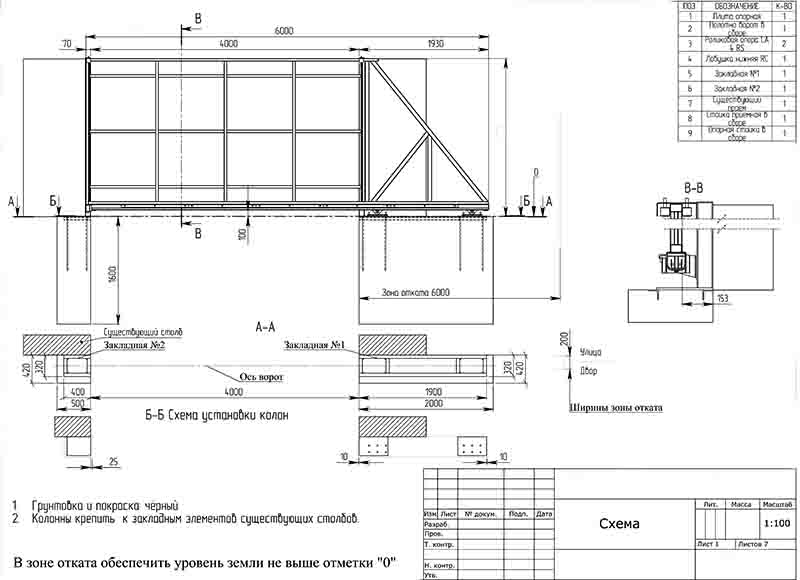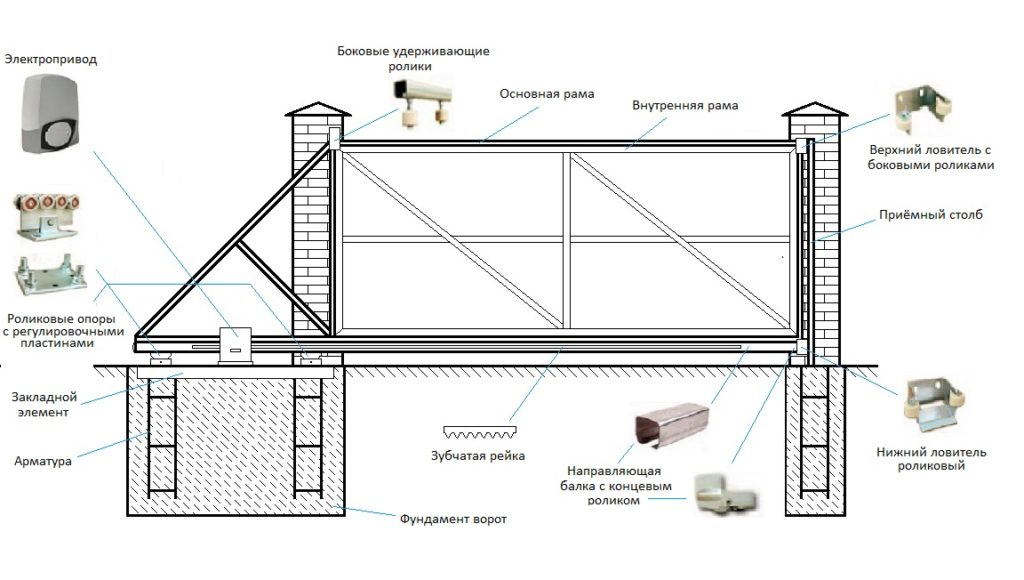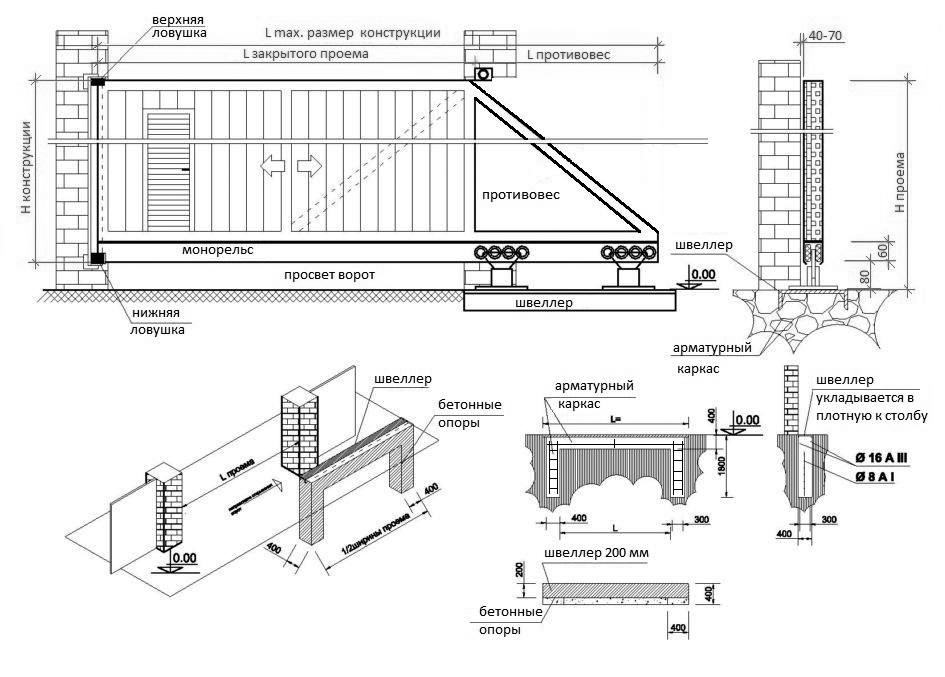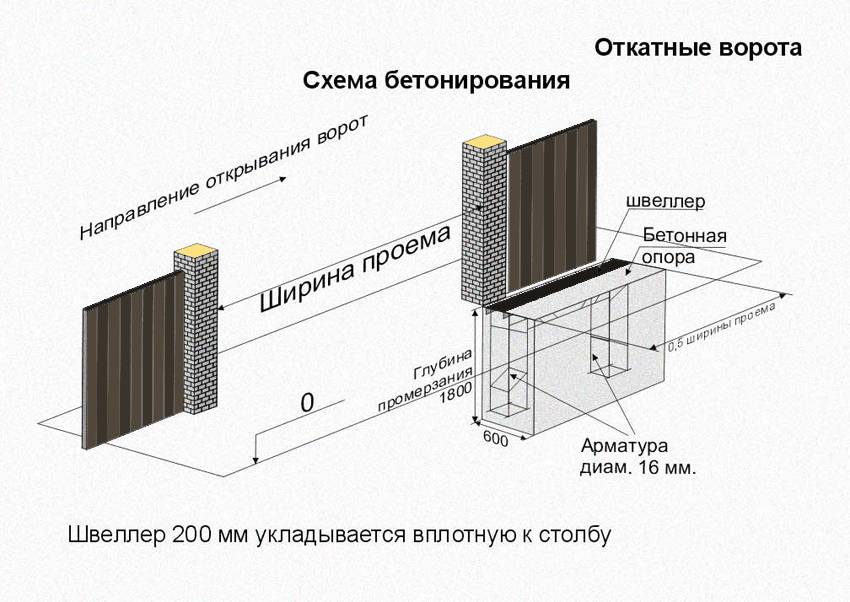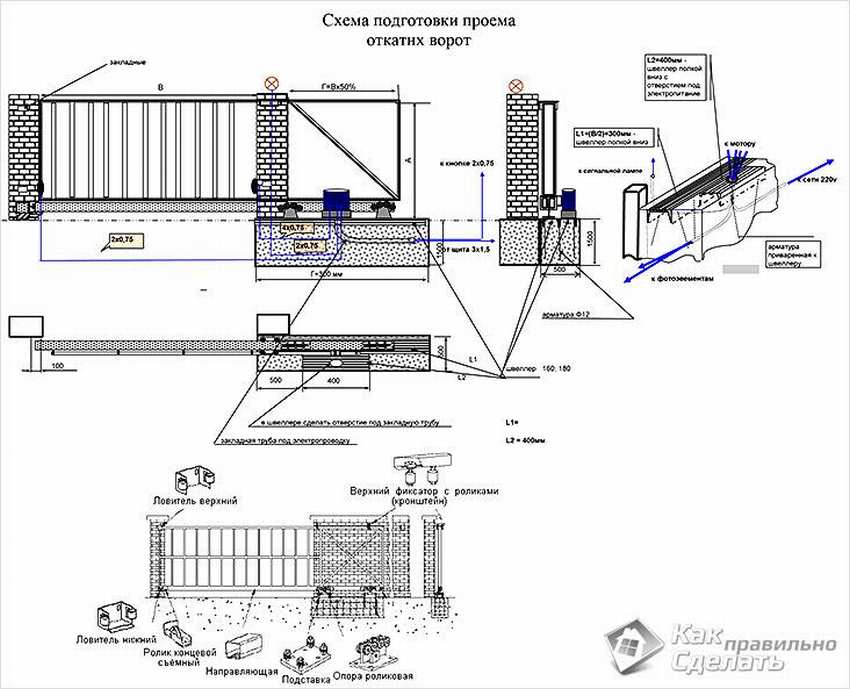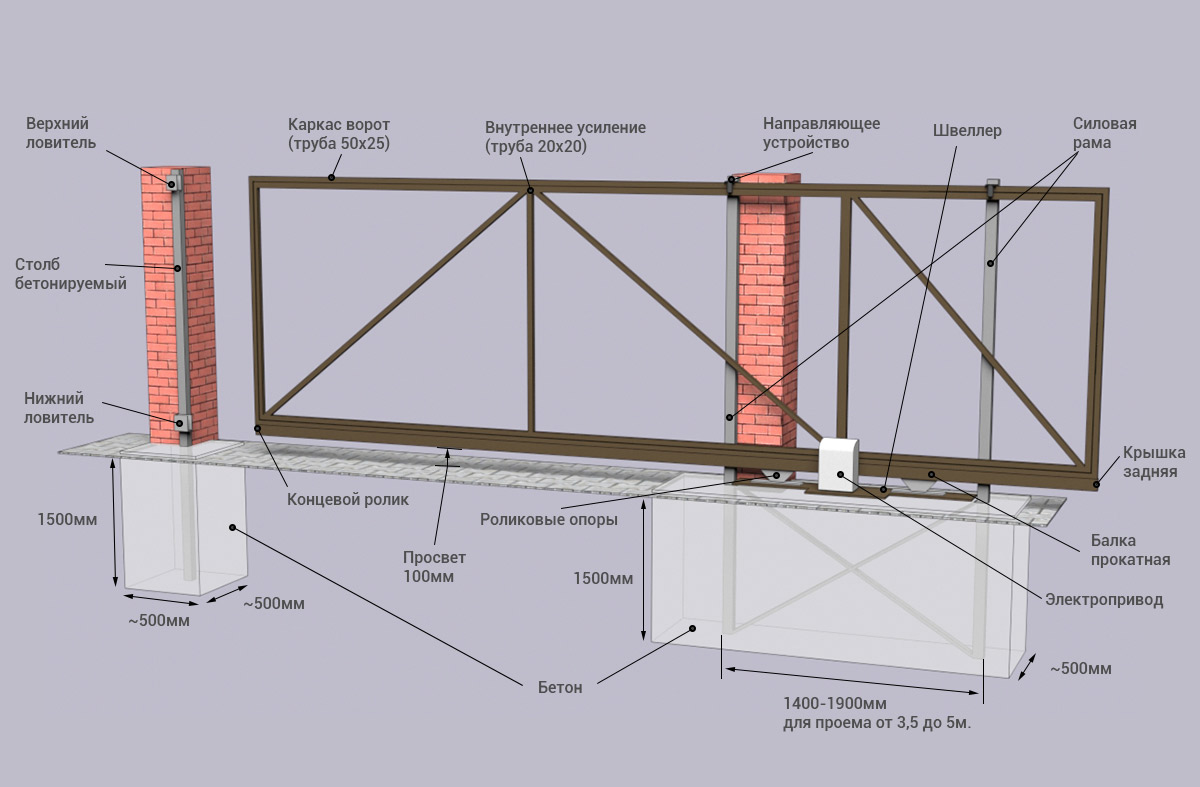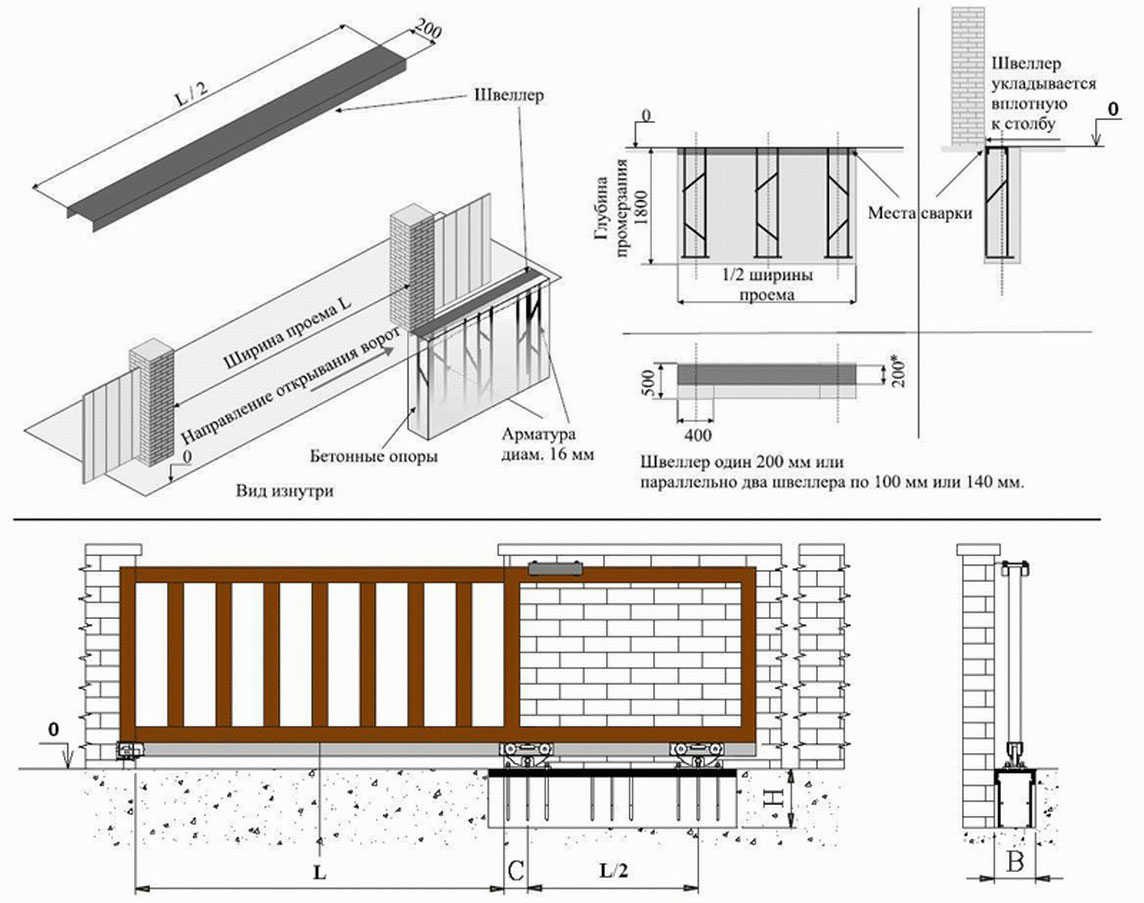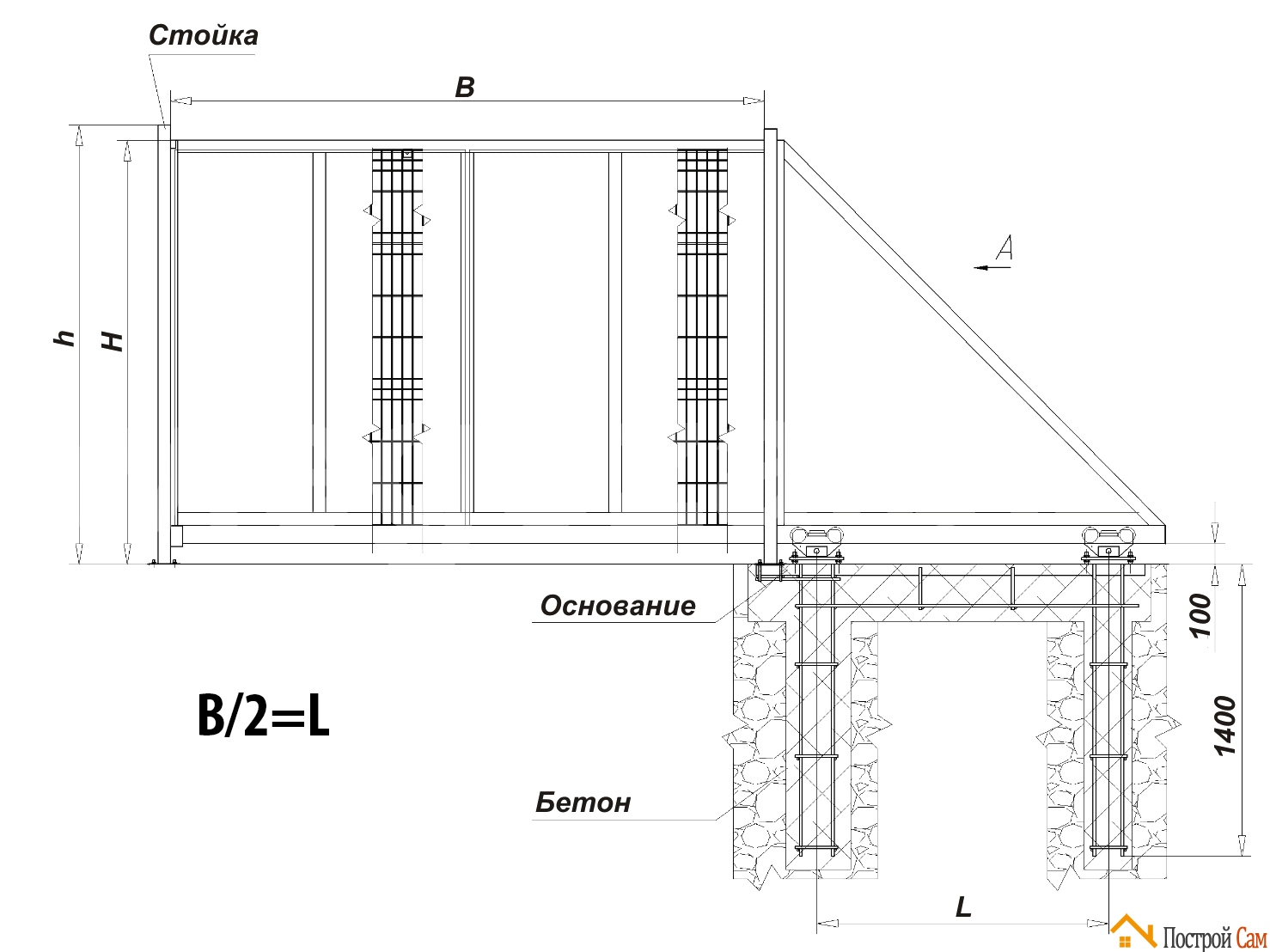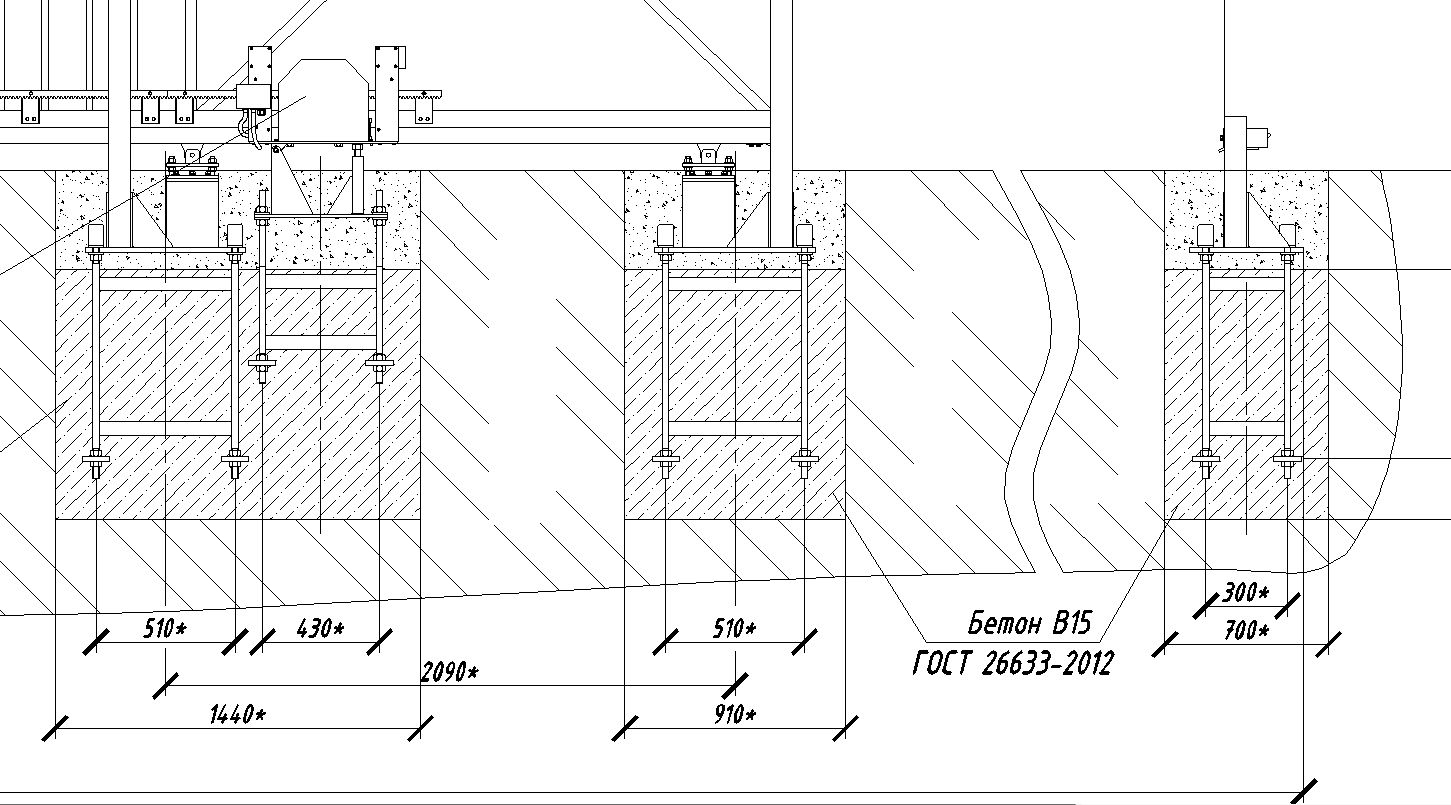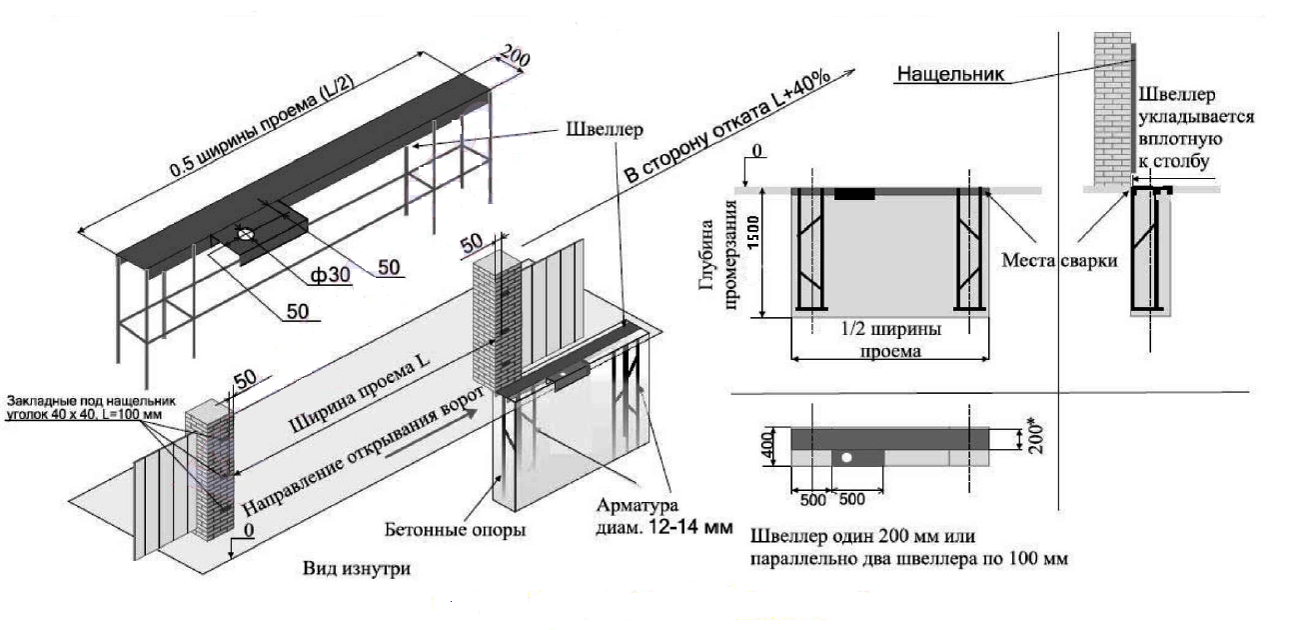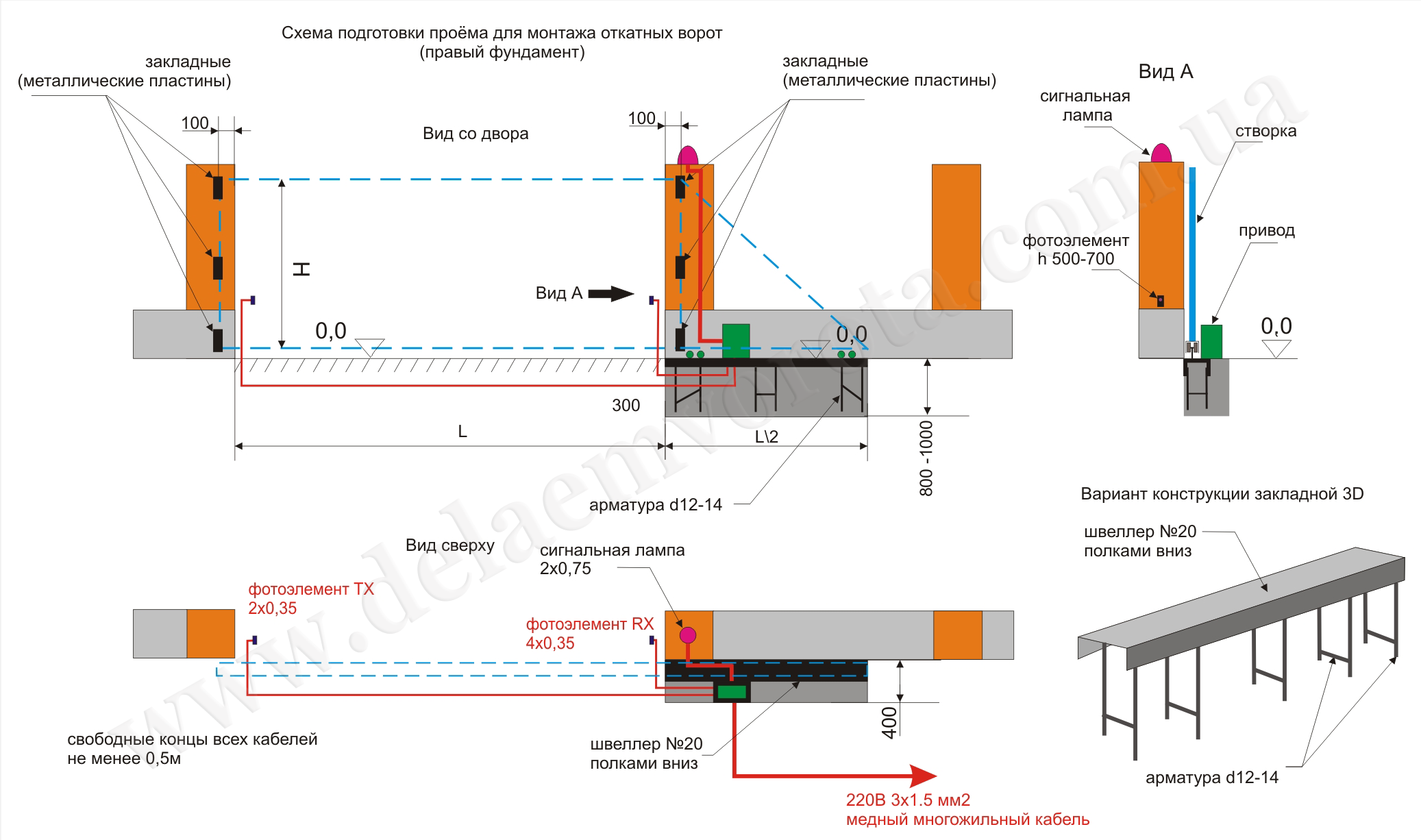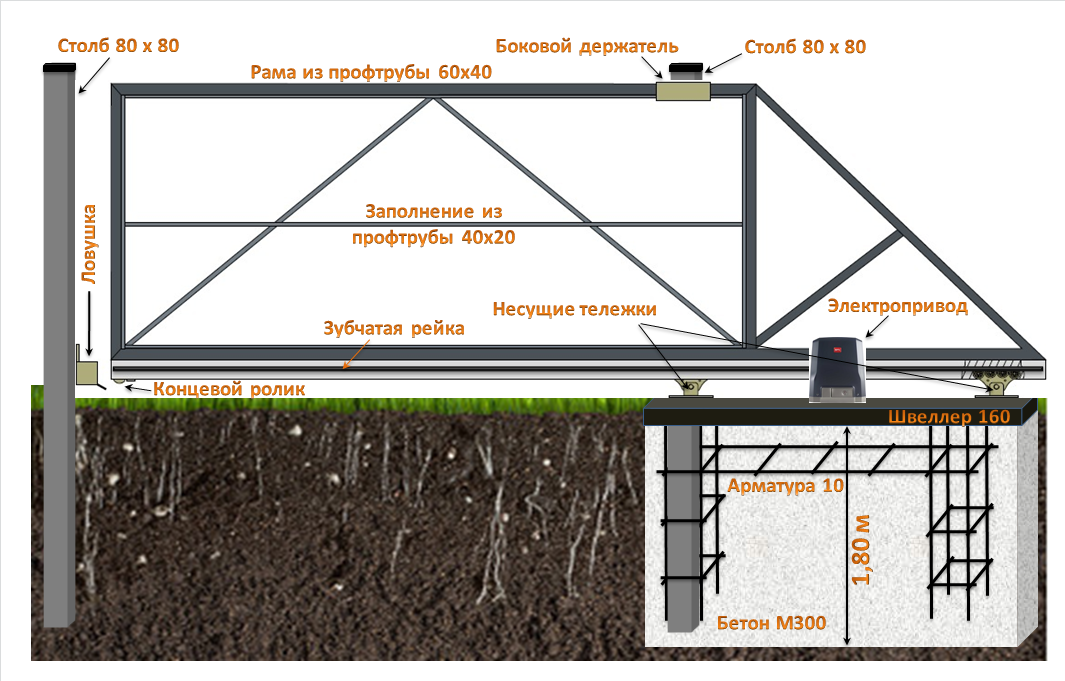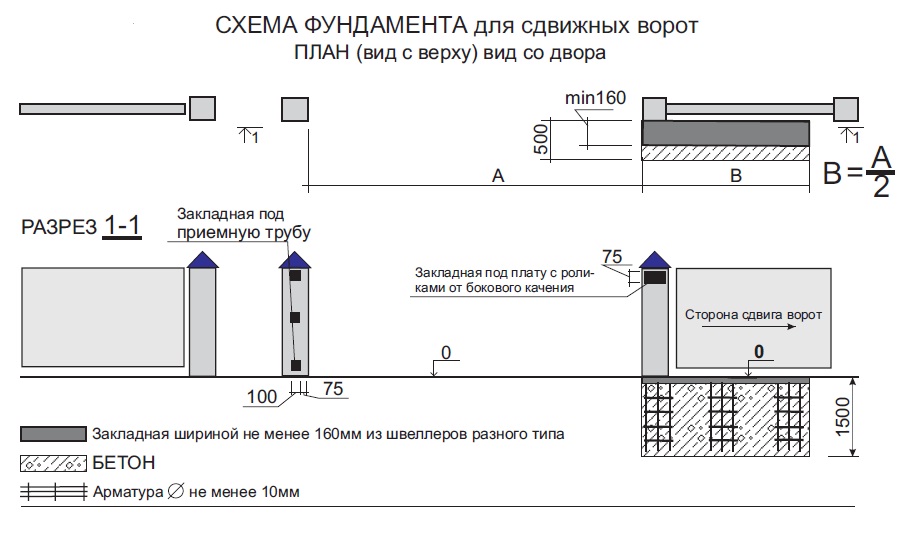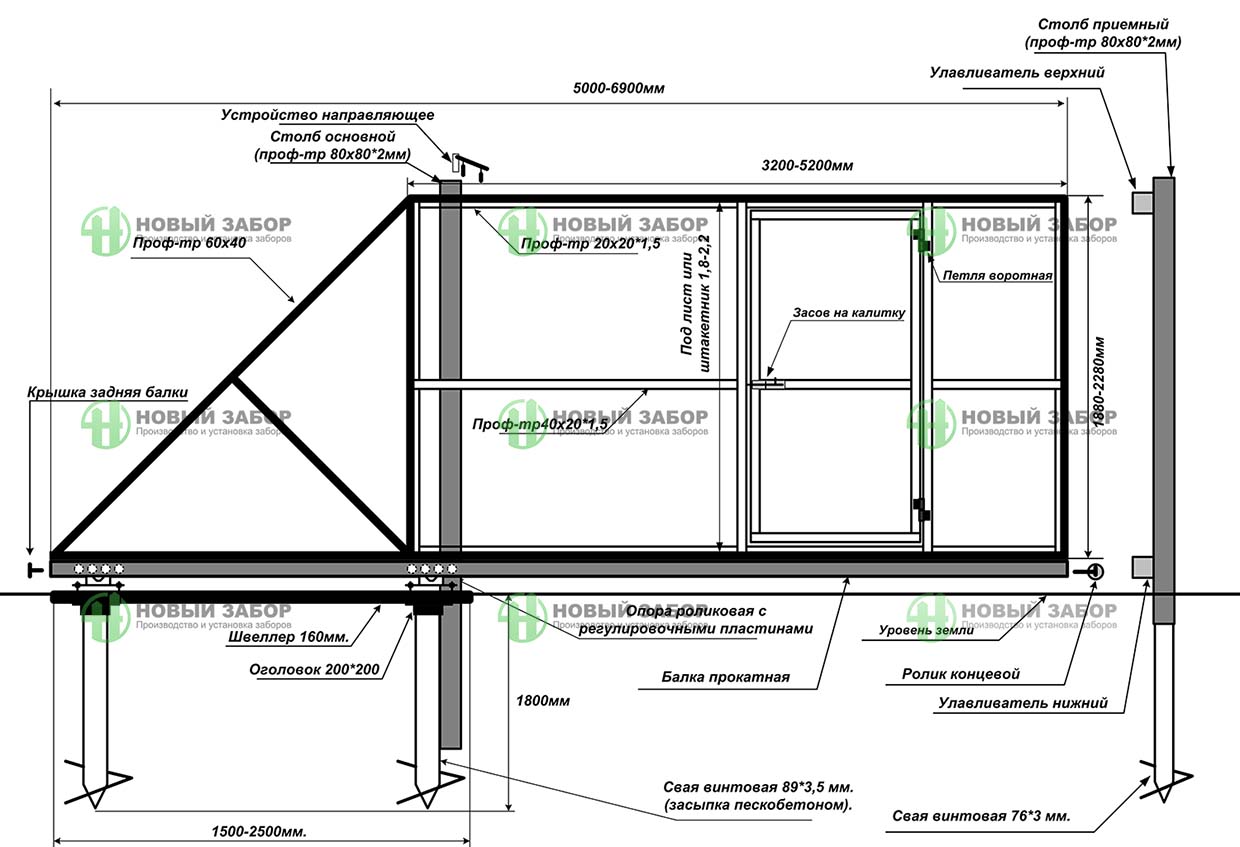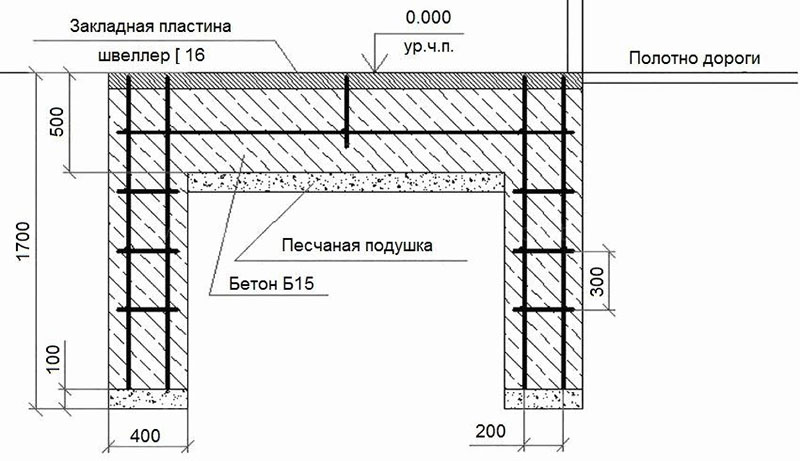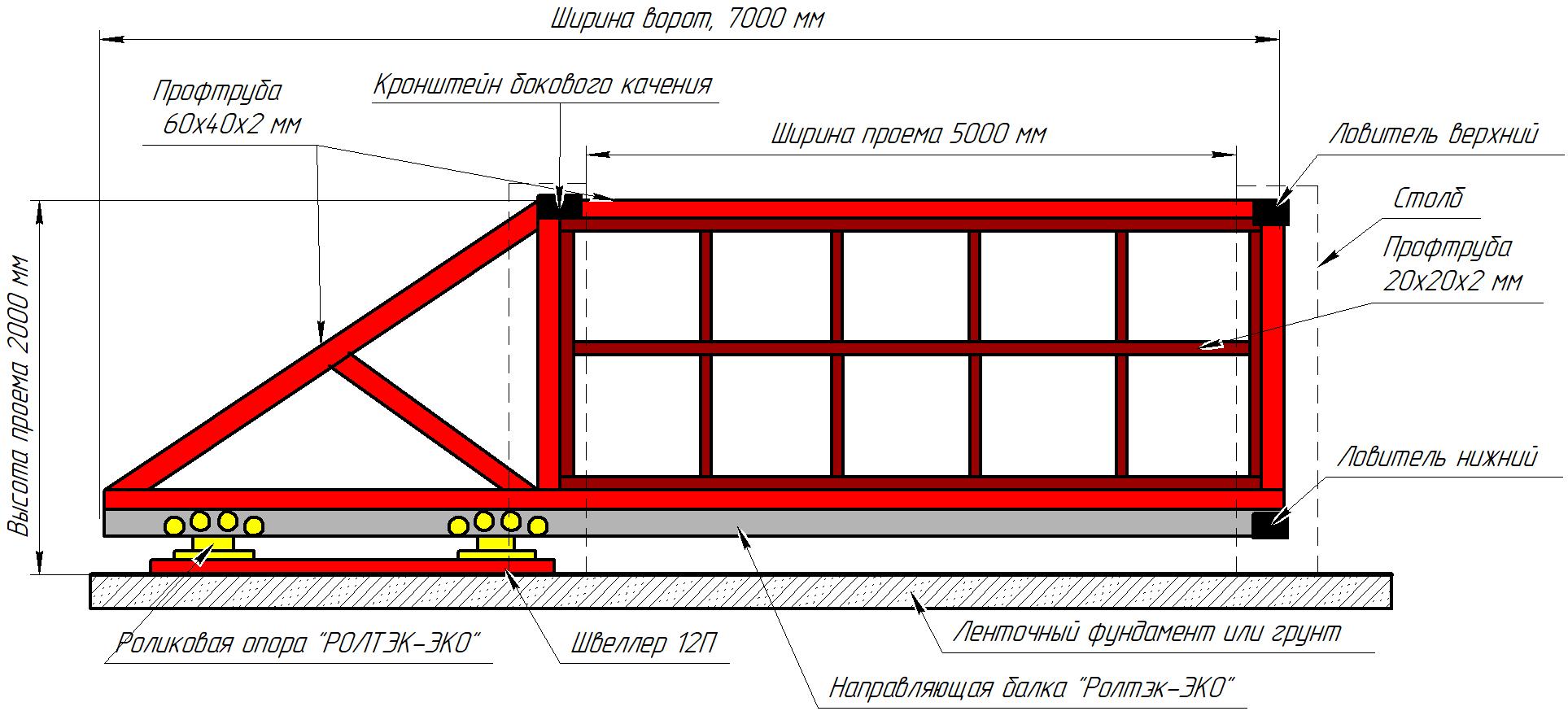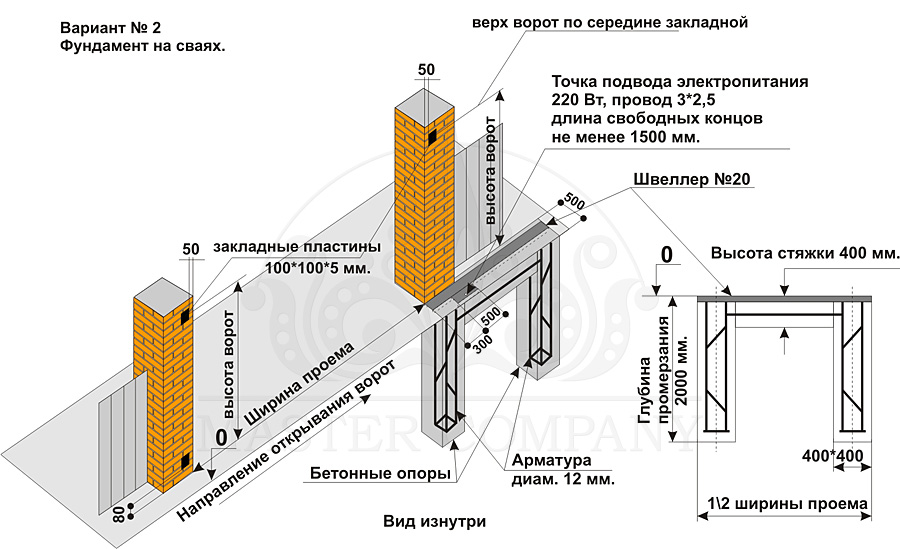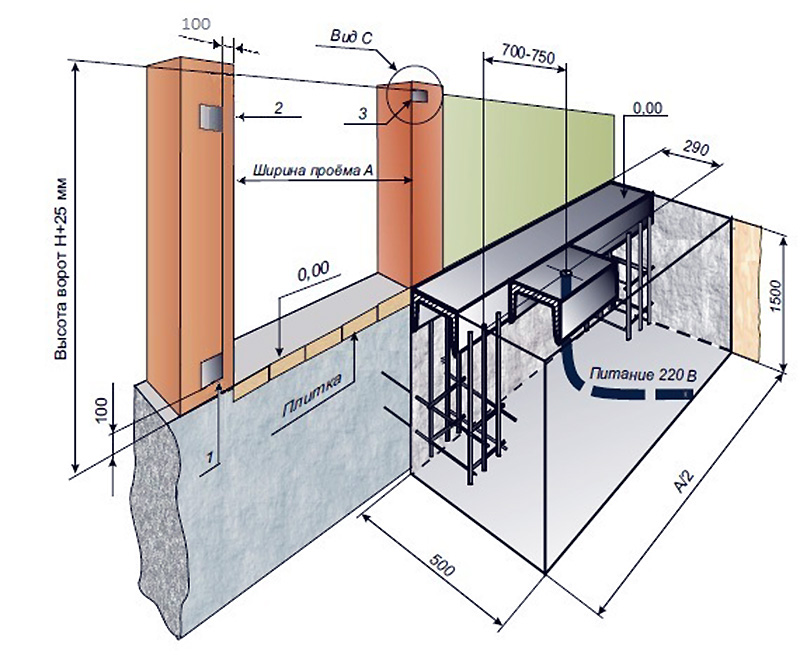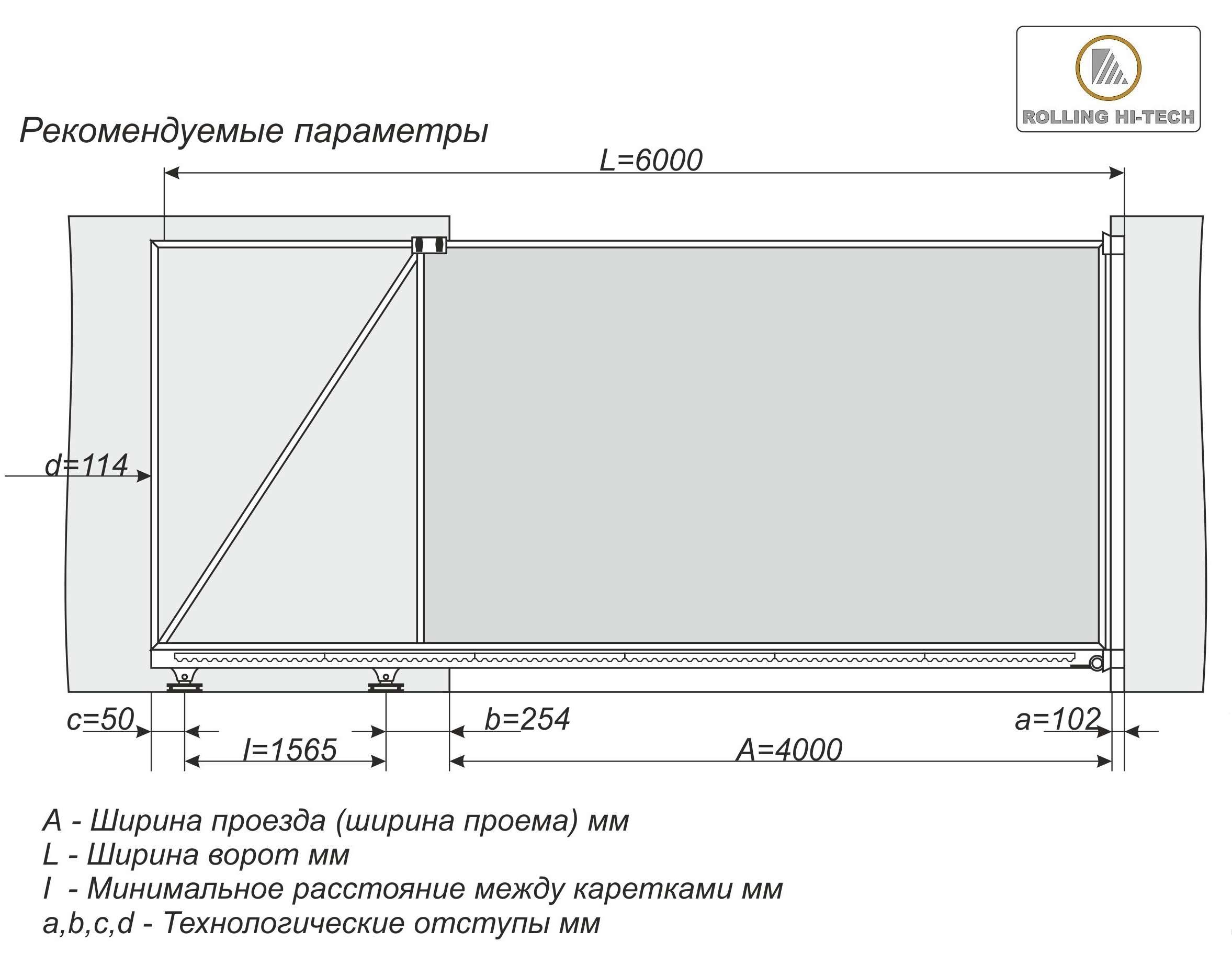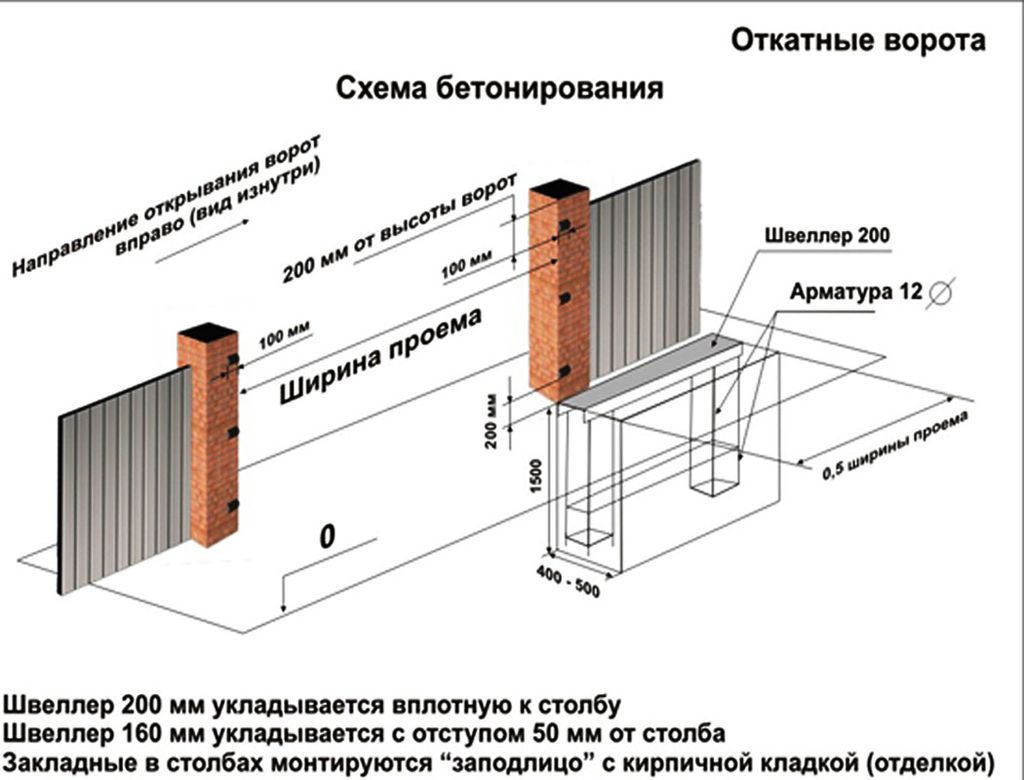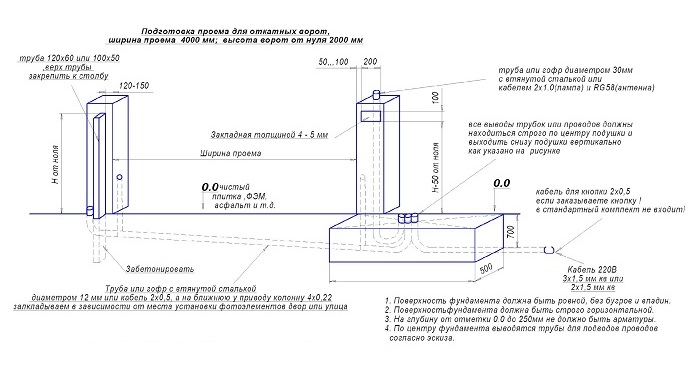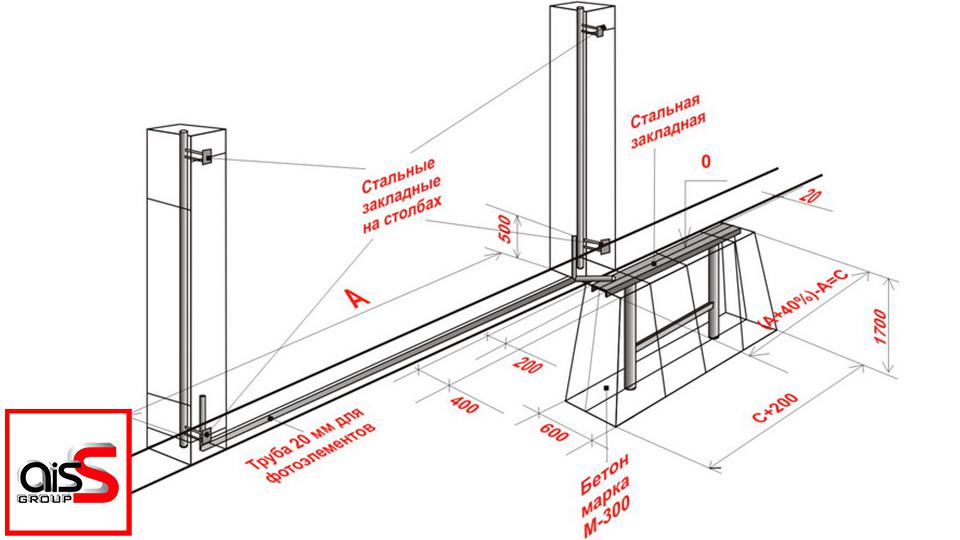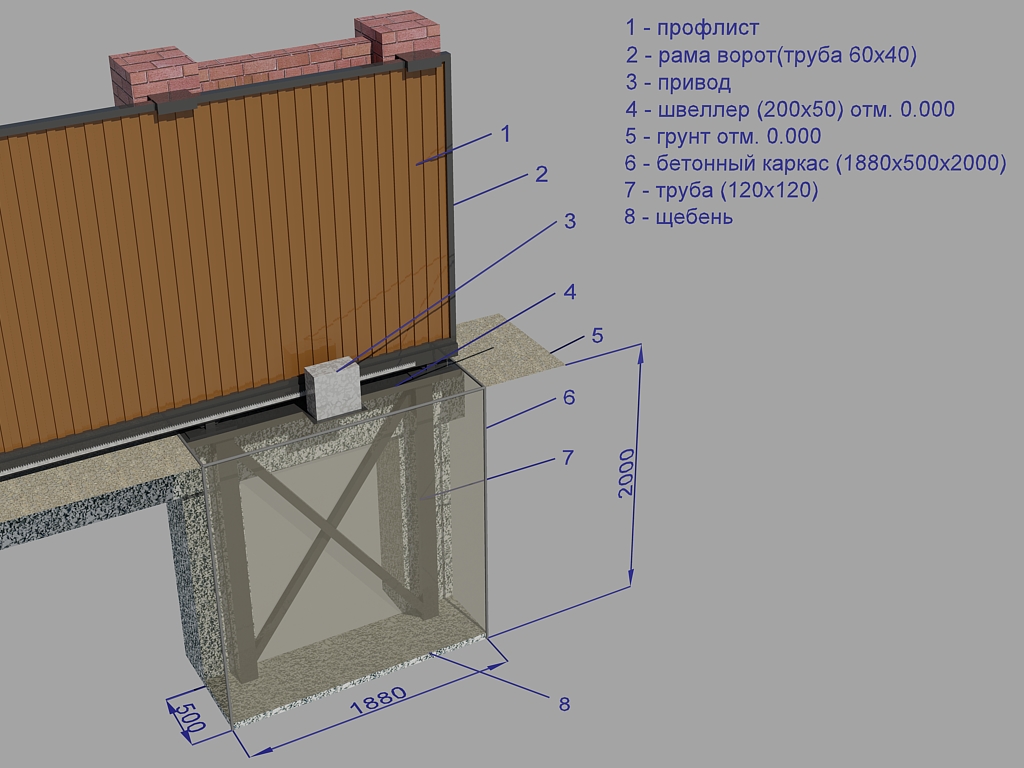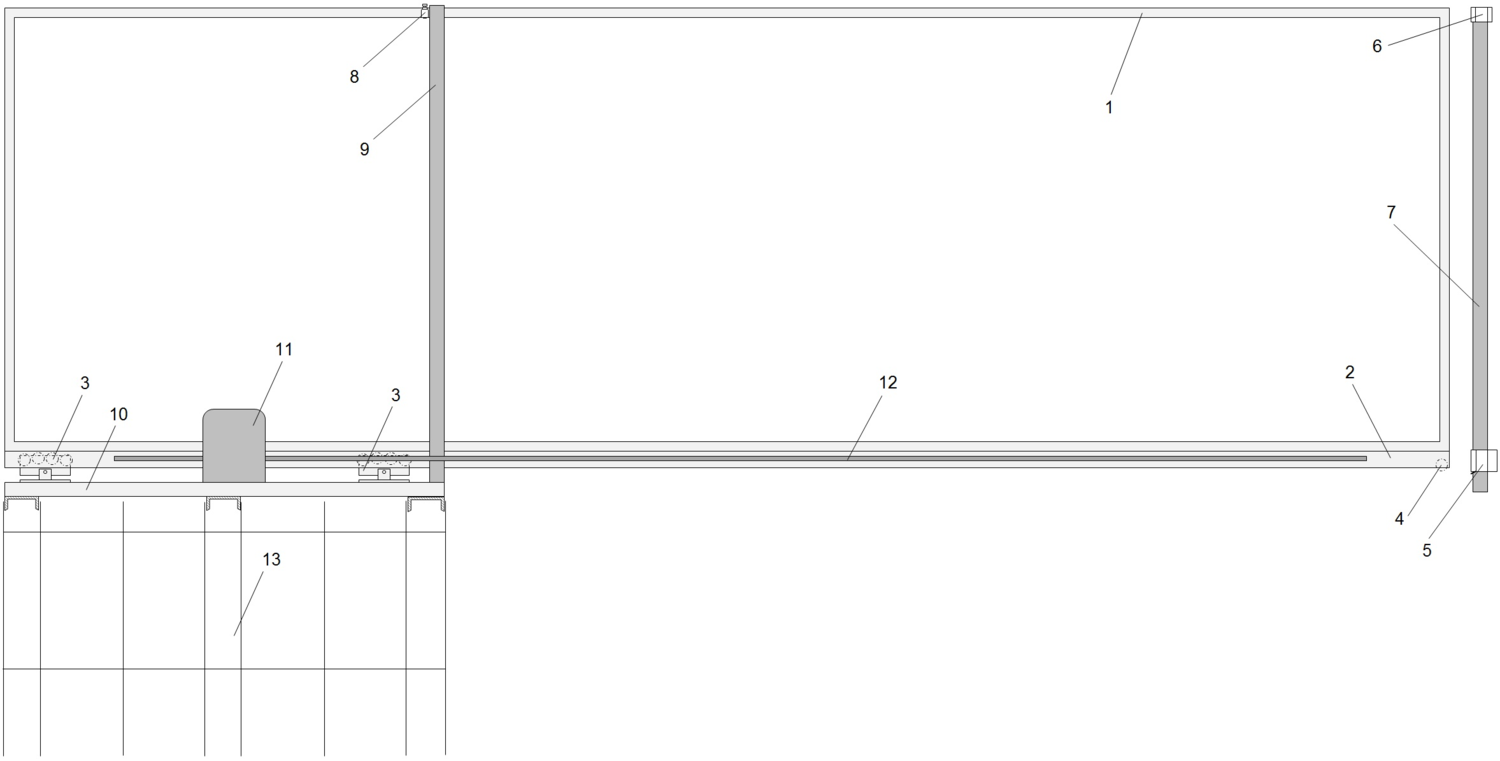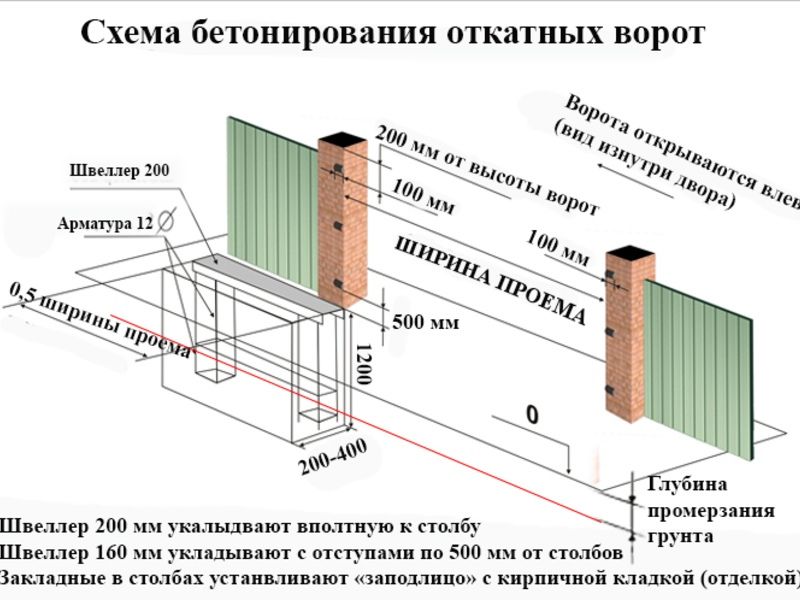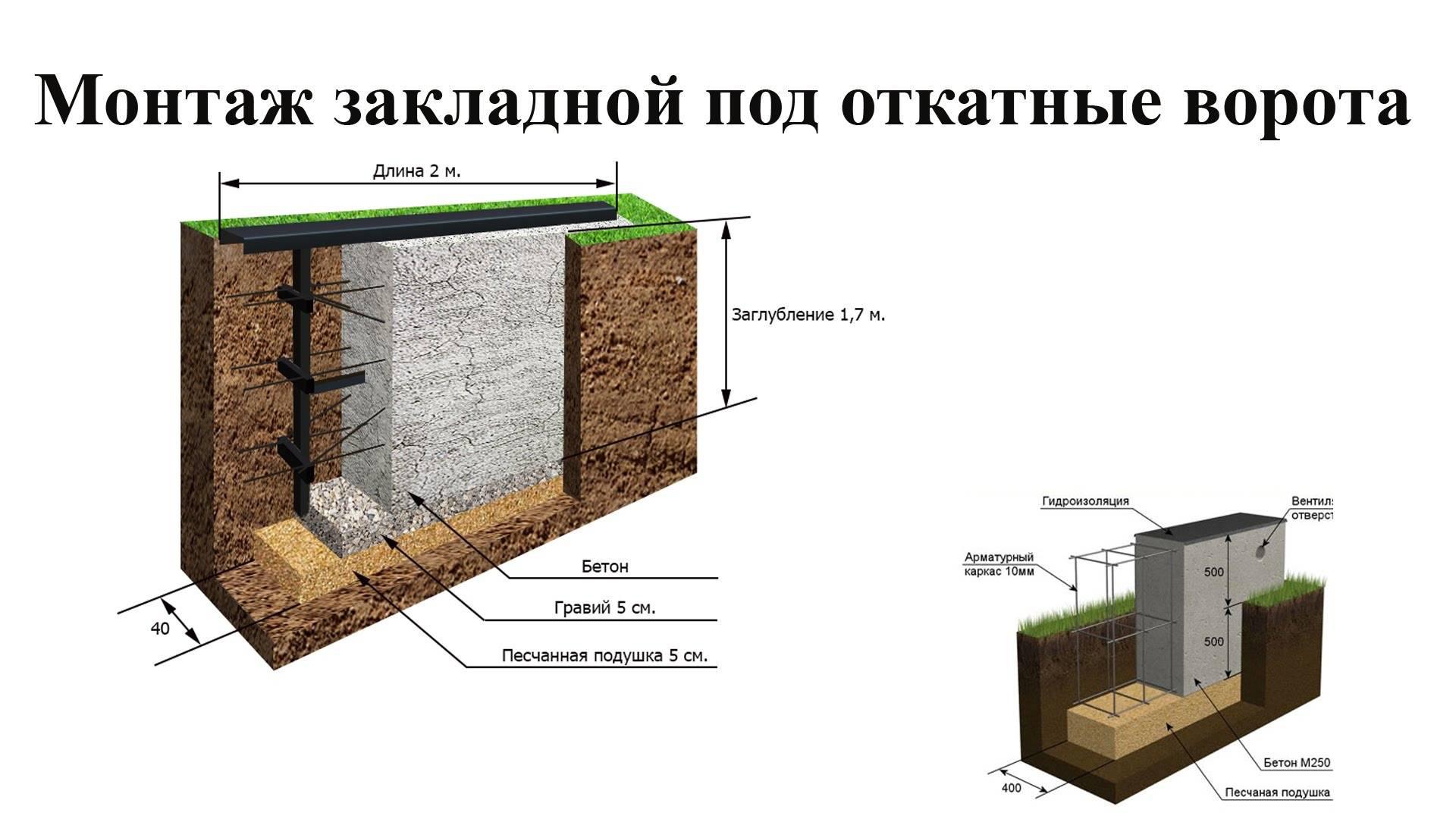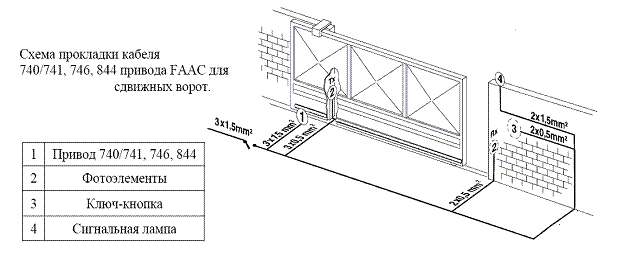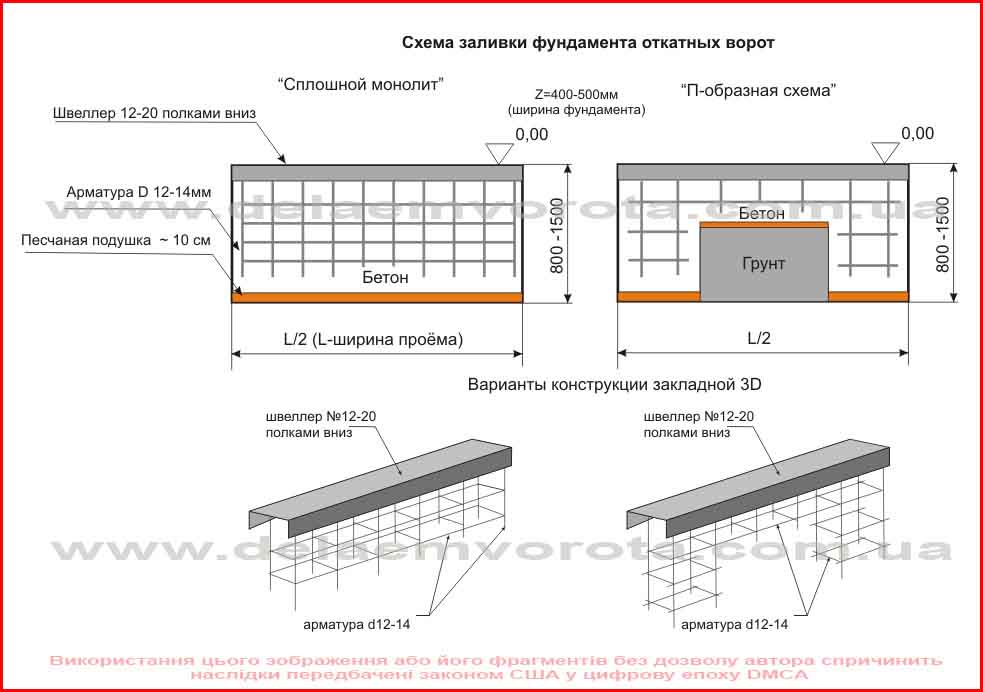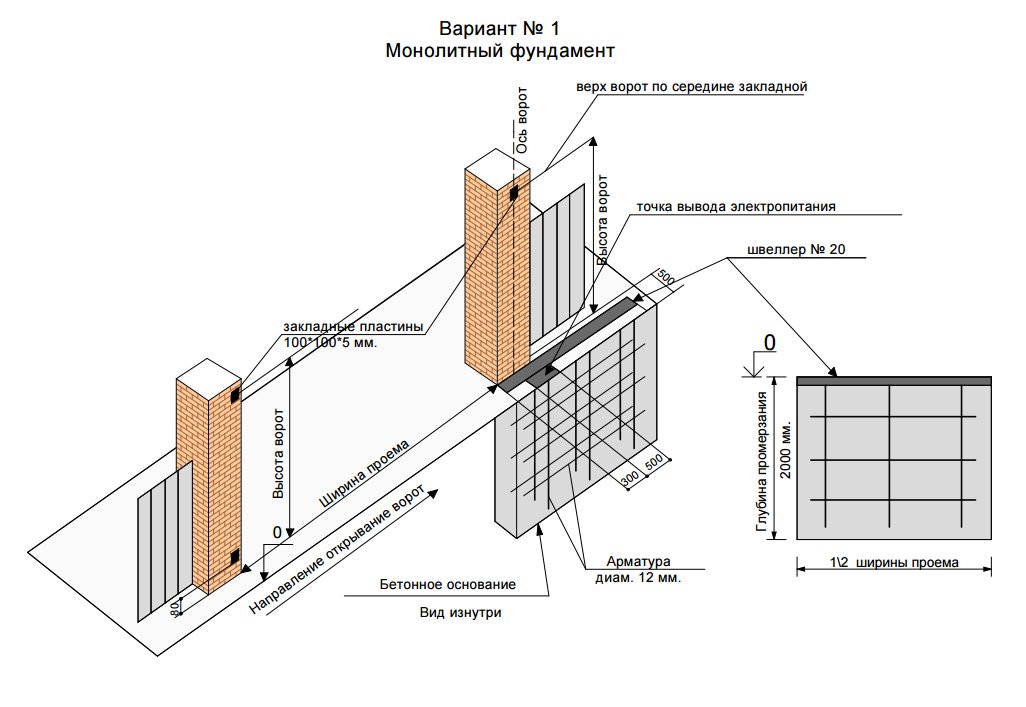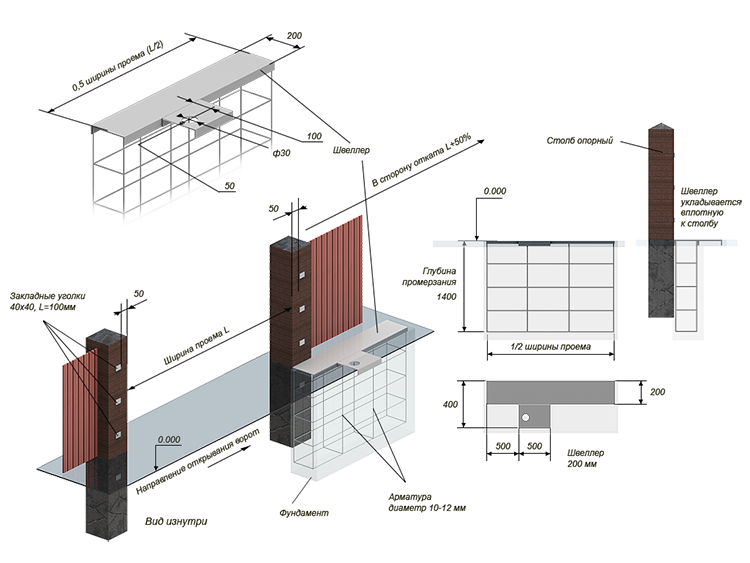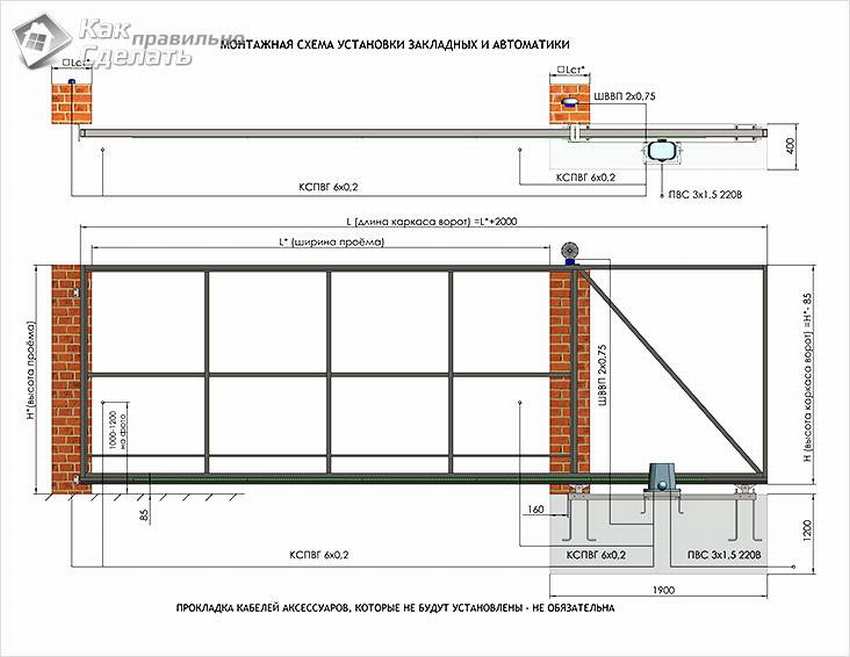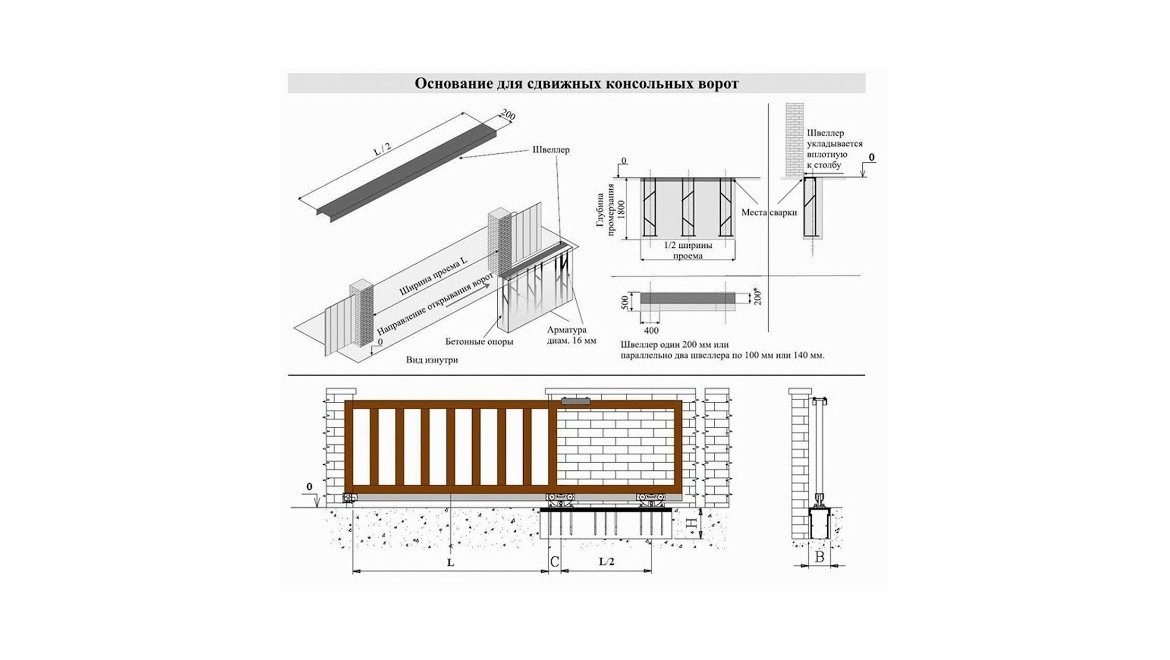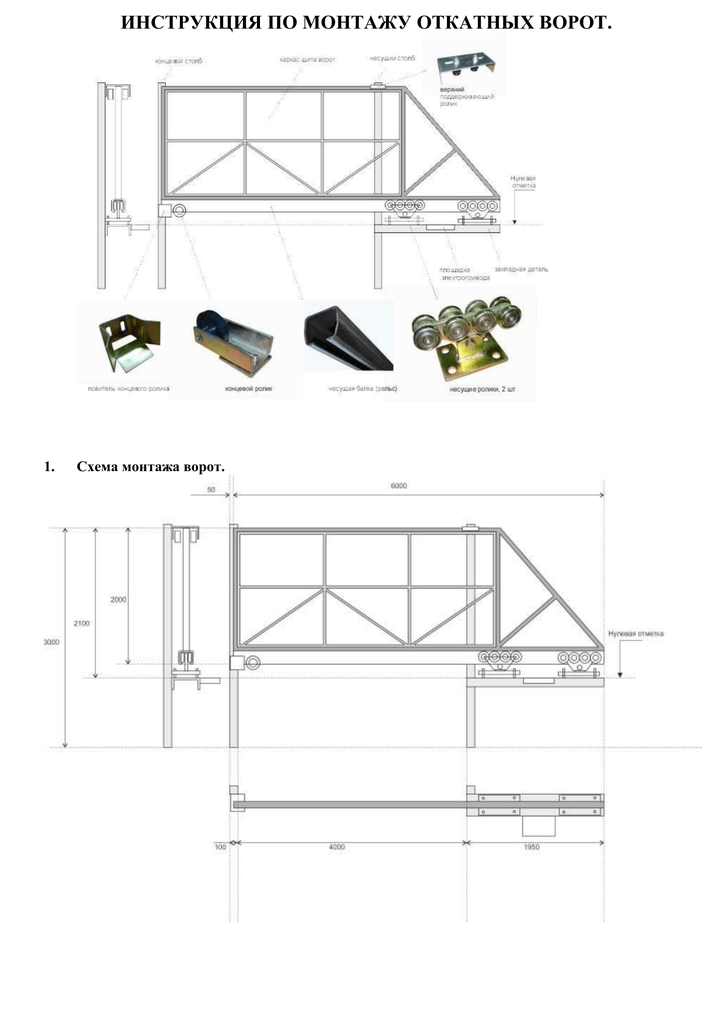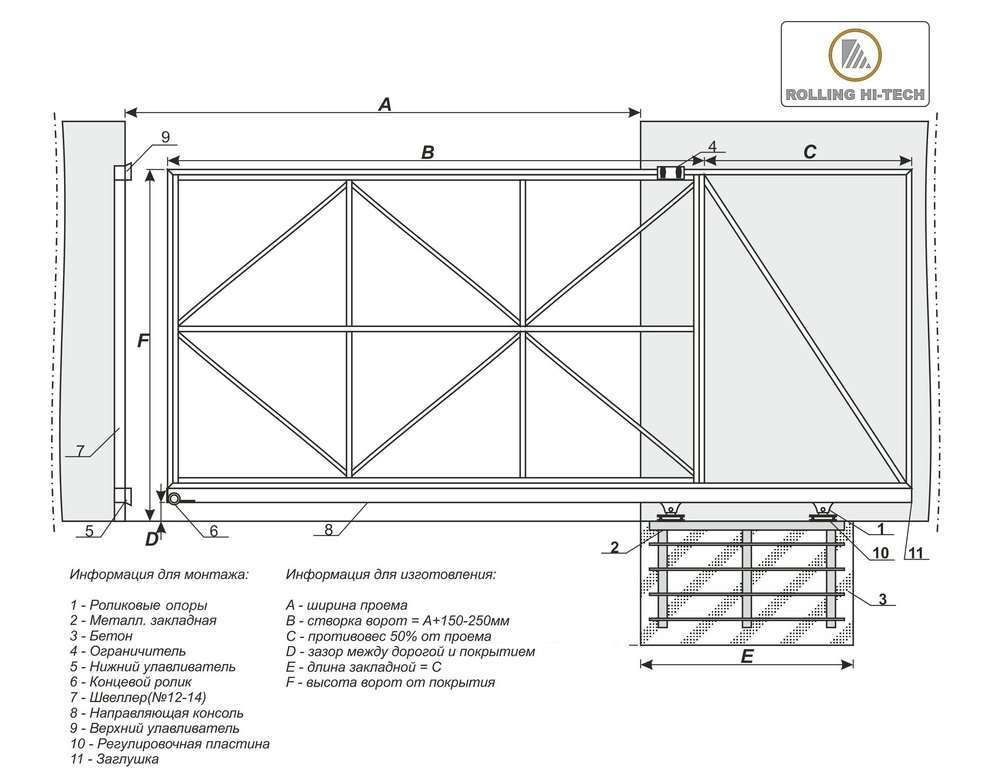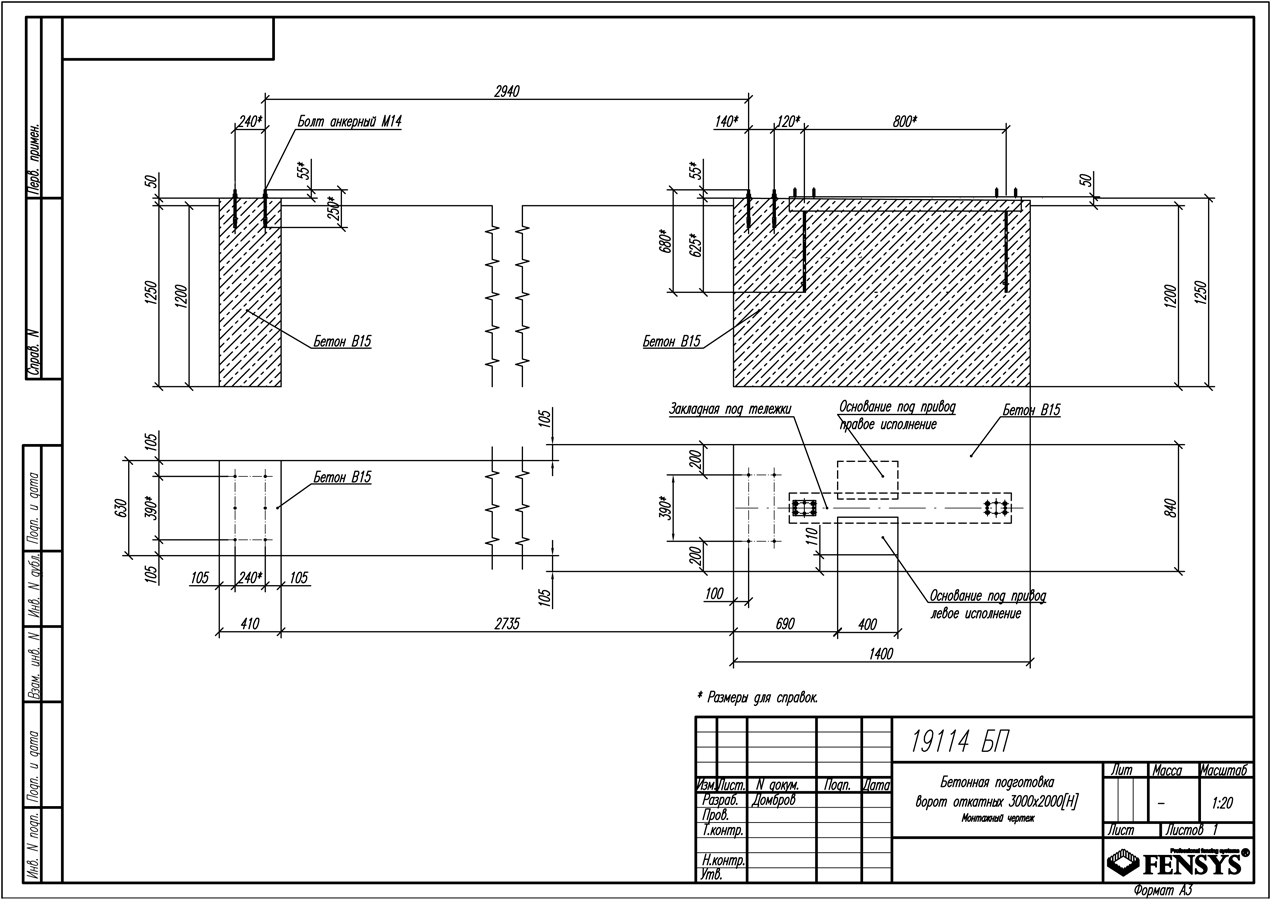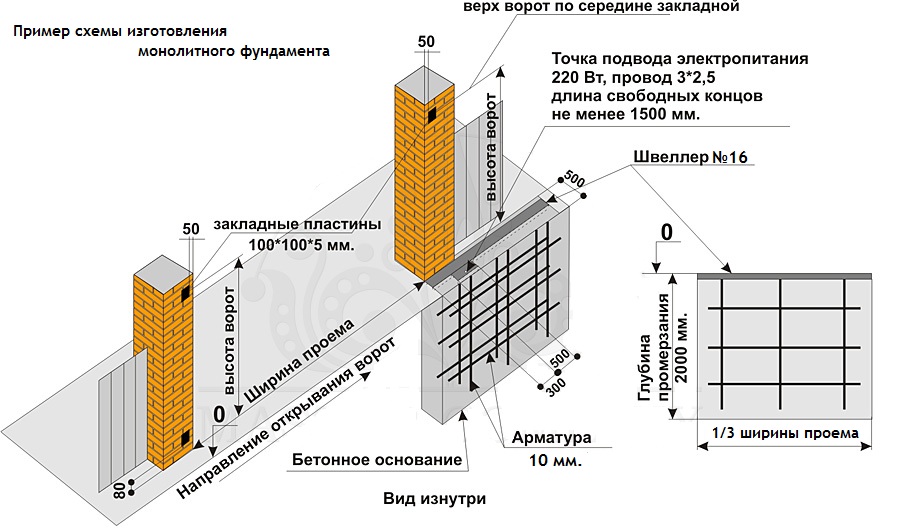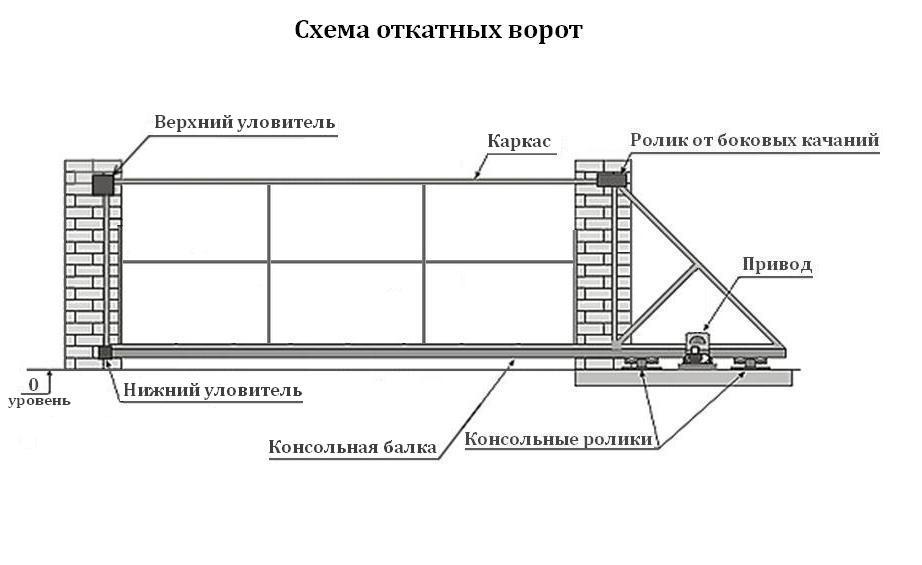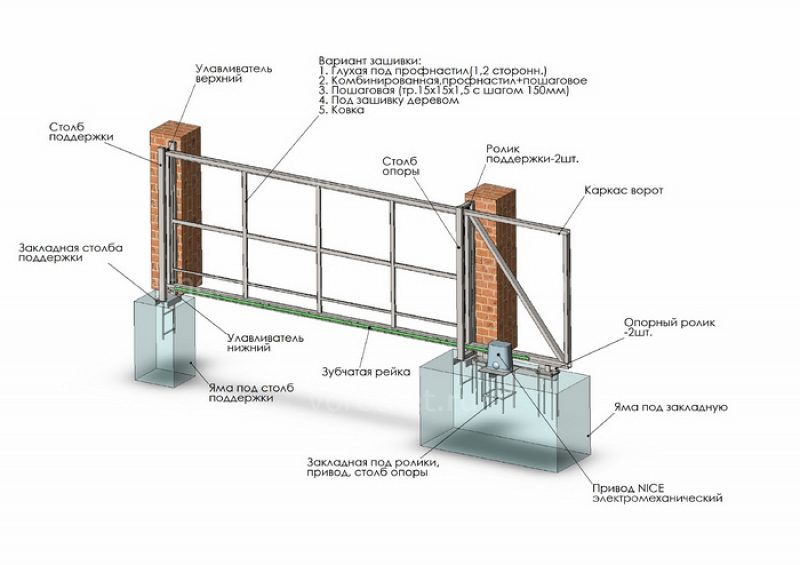Advantages of automatic gates
Automatic sliding gates are easy to use every day. The main advantages of automation are:
- Convenience: all automation systems can be controlled by just one console.
- Simplicity: you can open them without leaving your car or at home, with one press of a button on the remote control.
- Reliability: automation devices extend the service life of the door, because promote smooth acceleration and deceleration at the beginning and end of the maneuver.
- Security: the automated gates are equipped with a security system and stop moving if there is a risk of collision.
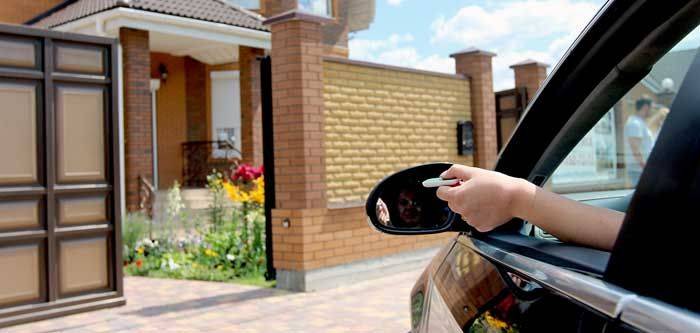
Gates without automation are less convenient in everyday life, but they will cost a little less. When making a choice in favor of automation, it is necessary to take into account the dependence of the engine power on the weight of the gate.
The motors are available in different capacities. Accordingly, for light structures, an ordinary engine of medium power is suitable. Heavy forged structures can be handled by a 700-800 W motor.
Since when installing an automation system, you will have to deal with electronics, not everyone can cope with this work on their own. You can install the machine if you have certain knowledge in this area.
If you are confident enough in your knowledge, and are ready to install the automatic system on the gate yourself, you will need the following materials and equipment:
- electronic drive for sliding gates;
- remote controls;
- elements for safety;
- bar with teeth;
- signal lamp;
- welding machine;
- drills for metal and drill;
- drives for connecting safety elements;
- electric drives for power supply;
- actuators for connecting a warning lamp.
You will also need a channel and a pair of carriages, since an electric drive will be located on the channel.
Installation of automation consists of several stages:
- choice of location for the electric drive;
- laying the drive on the channel and securing it with a toothed rack;
- welding the rail to the profile pipe;
- installation of limit switches;
- connection of the drive.
In addition to automation, it is possible to install surveillance cameras, anti-burglary devices, an intercom and other options on the door that can increase the comfort of users.
A few words about foundations in general.
It is assumed that the foundation rests on a frost-free layer of earth. That is, on soil that does not experience freeze-thaw cycles. This is the "freezing depth". Such a device significantly increases the lifespan, especially if the gate is made by hand. It is usually almost impossible to find an explanatory explanation of what this depth is.
Foundation concrete, another story. It is obtained from cement, from mixtures, crushed stone, and soon someone will guess that you can make it from plaster compounds.
More reinforcement. This is also a curious set of facts, with references to standards, intimidation that you cannot reinforce with your own hands without welding, with other horrors of the latest technologies.

There are several more "recommendations", such as that "the foundation must be strengthened", however, they usually keep silent about how exactly, that the gates can "float", without indicating the direction, and other stories of about the same cost.
So, what is the foundation for a gate, from the point of view of a practical person who is ready to do this not the most difficult job with his own hands?
Features of calculations
Before proceeding with the design of the drawing, you need to do all the necessary calculations. First of all, the height and width of the gate are calculated. If the height of the fence on the site is known, then the height of the future roadway can be determined as follows: the upper part should be the same level with the fence, and the lower part should be 8-10 cm above the roadbed. The door width is equal to the distance between the support beams, the recommended value is 4 meters.
It is also quite simple to calculate the counterweight - its length should be equal to 50% of the opening length. This value can be reduced to 40% only in cases where there is not enough space for the fence to fully open the sash and the canvas is sheathed with lightweight materials.

The length of the counterweight profile connecting the top of the web and the edge of the lower profile should be sufficient to form a triangle.
The value is calculated according to the dimensions using the following formula:
sqrt {func a ^ {2} + func b ^ {2}}
Or in a more familiar form, familiar from school
Where a is the length of the counterweight, b is the height of the web, c is the desired length.
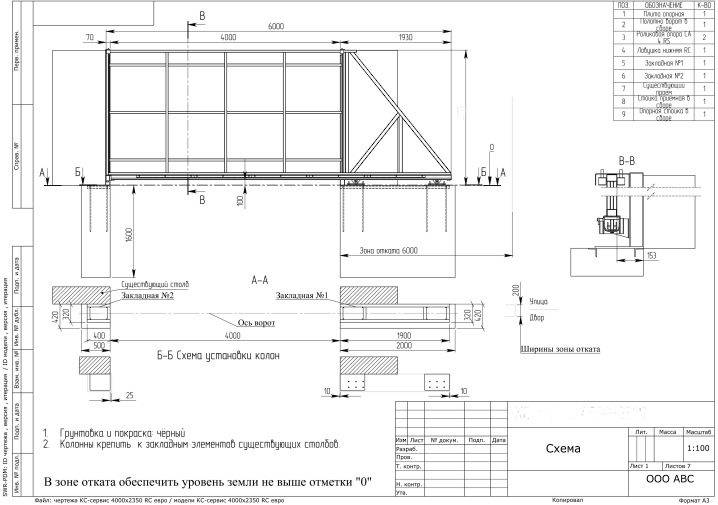
Calculation of the weight of the structure is needed for the correct selection of the guide beam, fittings and automation. Basically, the weight depends on the material with which the sheathing will be made, on the weight of the frame, frame and supporting beam, and on the wind load.

For gates weighing up to 300 kg, a supporting beam with dimensions of 9x5 cm and a metal thickness of 3.5 mm is suitable. The hardware must be able to support the full weight of the structure. It can be purchased as a ready-made kit, or you can purchase all components separately. When buying, it is advisable to have a drawing with all the calculations with you so that you can consult with a specialist.
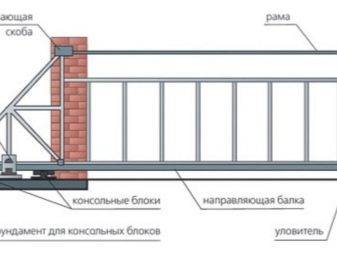
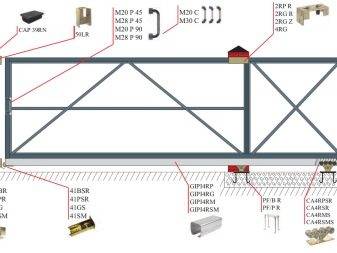
Gate installation
Installation of the door leaf is carried out in stages:
- Marking the required space for moving the sliding sash.
- Roller carts manufacturing.
- Calculation of the limits of movement of the rollers.
- Assembly.
- Adjusting the door leaf and checking the operation of the roller supports.
- End roller attachment.
- Installing the guide bracket.
- Counter support device.
- Sheathing of the gate frame.
- Fastening of safety devices and necessary automation.
In the manufacture of sliding gates, the place for movement and their installation are calculated. During the assembly of the structure, they are installed in the profile and slightly moved towards the center of the mortgage, the door leaf is installed on them strictly vertically.
The counter post is necessary for attaching catchers, and at the same time makes it possible to cover the resulting technological gap. They mount it close to each other and fix it, fixing it to the fence post opposite the embedded element.
The door leaf can be sheathed using various materials, for example, corrugated board or wood. The plating method is chosen taking into account the design of the structure and material.
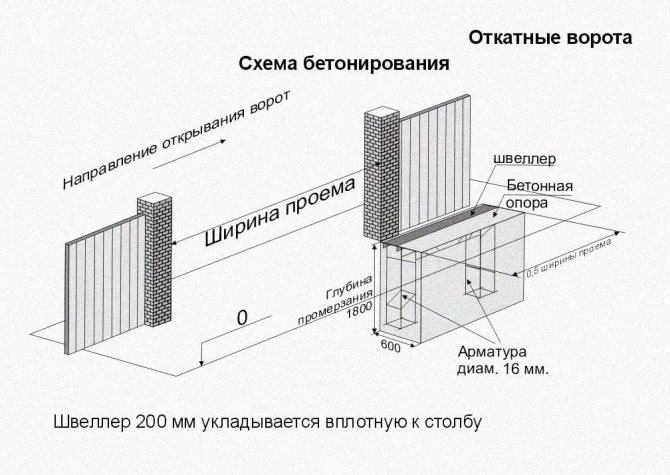
Step-by-step installation of sliding gates
To avoid mistakes when installing sliding gates and to get a reliable and durable structure, it is better to break the process into several stages and follow the plan. The following works can be distinguished:
- installation of supports;
- foundation making;
- sash construction;
- installation of the entire system.
At each stage, it is important to observe all the parameters of the technology and control the geometry. Correctly aligned door guides will ensure minimal effort during door movement
Installation of pillars
For the stability of the entire structure, it is necessary to make the pillars of the supports as efficiently and accurately as possible. Installation features depend on their type. They can be made from:
- concrete;
- bricks;
- stone;
- rolled metal;
- wood.
When the supports are made of brick, stone or concrete, you need to make mortgages in order to then fix the catchers and tires.
For the stability of the post, before installing it in the pit, you can weld pieces of reinforcement, pipe or corner to it as cross-members.
The pit must be at least 1 m deep and 0.5 m wide. The supports are leveled and poured with concrete.
Construction of the foundation for the gate mechanism
The correct operation of a sliding gate mechanism cannot be ensured without a foundation. When marking it, you need to take into account that it should be 0.3 m longer than the counterweight.
Work order:
- The width of the trench is marked by stepping back half a meter from the fence line.
- It is better to deepen the foundation below the freezing point of the soil. The depth should be at least one meter.
- With the help of a channel, which will be a mortgage for fastening carts, and cut reinforcement, a U-shaped structure is made.
- It must be set according to levels and height, since roller carriages are installed on it.
- Armopoyas and formwork are being built.
- Concrete mix is prepared and laid.
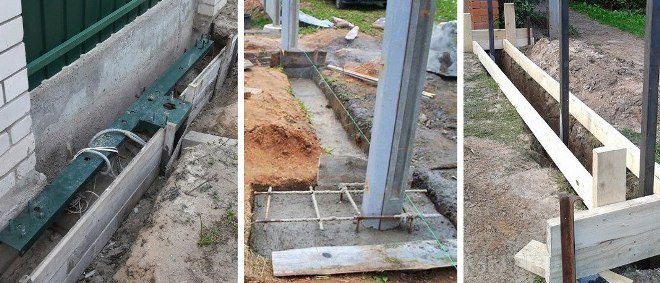
Sash manufacturing. Welding
You will need a flat platform so that the structure does not lead during assembly.
Installation sequence:
- The pipes are laid on transversely arranged wooden blocks, leveled using a reliable level, better than a laser one.
- Structural elements are boiled from bottom to top. First, every 0.5 m, a prepared profile pipe and a guide beam are connected with a 2 cm seam.
- The pipes that determine the height of the sash are attached perpendicularly to the resulting twin. If the counterweight is in the shape of a rectangle, then all the cross members are of the same length. To maintain the plane of the structure, it must not be overheated.
- Install the transverse upper beam.
- Stiffeners are welded to the prepared base of the frame in accordance with the drawing. For this, pipe blanks 40 * 20 * 2 are used.
Painting and installation of filling
You can make a sliding gate from a profiled sheet. The industry produces it in different colors, waveforms and metal thicknesses.
Before plating, it is necessary to clean the welds with a grinder and prime the finished frame. It is best to use a primer containing anti-corrosion additives.
Profile sheets are fastened with rivets or self-tapping screws.
Installation of sliding gates
Before assembling the entire system, markup is done. To accurately install the cantilever supports, pull the cord along the sash. 70 mm retreat from the pillars (the thickness of the canvas), from the road surface the cord is raised by 15-20 cm.
Further procedure:
- The front roller trolley is recessed in the direction of the sash rollback at a distance of 15 cm so that it does not go out onto the roadway.
- The second assembly is placed at a distance of 10 cm from the receiving post, so that it is possible to place the catchers.
- The pads of the supports are tacked by welding, the carriages are installed and the canvas is rolled onto them for verification.
- If the system works well, then the sash is removed, the support is disassembled and fixed completely.
- After the sash is installed, it is closed and leveled using a level and adjustment bolts.
- Mount the limiter and the knurling roller. Install the catcher at the bottom, align it and put the top one.
- They make final adjustments, put plugs, clean weld spots and paint.
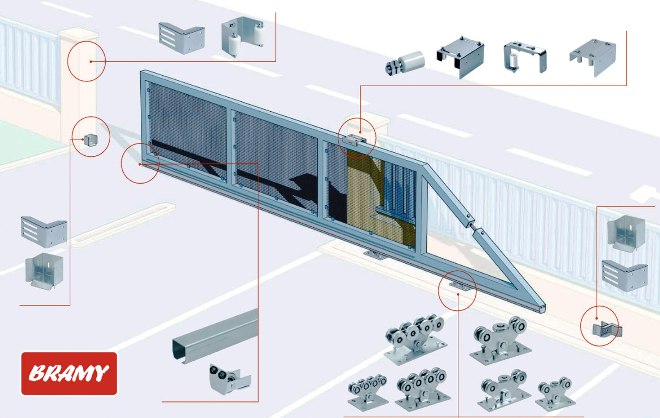
How to pour a strip foundation under a sliding gate
In order to properly fill the foundation, it is required to initially prepare the tools and materials necessary for work:
- sand, crushed stone and cement for concreting;
- cantilever metal blocks;
- longitudinal metal channels;
- reinforcing bars and knitting wire. A frame is assembled from them;
- unedged boards for formwork;
- concrete mixer;
- electric or gas welding;
- construction level;
- roulette;
- bayonet and shovels;
- scrap;
- support channel;
- a hammer, a hacksaw for iron, as well as an ax and a corner for formwork.
It is better not to save on raw materials, as this can adversely affect the quality of the structure, its strength and, accordingly, reduce the service life of the sliding gates.
We start making the foundation:
-
We dig a trench with the appropriate dimensions, which were correctly calculated in the drawing. Its depth should be 35 cm more than the freezing point of the soil.
-
We install the formwork. Mortar consumption will decrease if you make a 100 mm thick sand and gravel cushion.
-
From the reinforcement we make the basis for the future foundation. We fix the rods together with wire or by welding. The distance between them should be about 30 cm.
- We install the prepared reinforcing belt horizontally. We deepen the protruding part 12 cm below the soil surface. We shift its frontal part to the edge of the opening. The distance from the chord to the formwork is at least 2 cm in all planes.
-
We weld a longitudinal channel to the belt, the shelf of which should be at the zero mark.
- We place the channel in the base and connect it to the frame. It is necessary for fastening the drive mechanism of the sliding structure.
-
We install the control and power cords through the pipes located in the frame. They must be at least 25 mm in diameter, otherwise the wire will be difficult to pass.
- We mix the solution in the following proportions: 6 buckets of river sand, 2 buckets of cement, 2 buckets of rubble and the required amount of water so that the mixture does not turn out very thick. Crushed stone adds strength to concrete. If you plan to use ready-made concrete mix, then it must be of a grade not lower than M200. To prepare the solution, we take cement M500.
-
We fill the pit with prepared concrete so that the belt does not shift, since the possibility of operating the gate depends on this. We do not use all the concrete at once, but only 1/3 of the trench volume. This method of pouring the foundation guarantees an excellent fixation of the belt. It will be necessary to install 3 transverse channels in the reinforcement cage.
-
We align the channels with respect to the vertical and horizontal. Then we weld them to the reinforcing belt and fill them with concrete solution. It will take about two weeks or more for the solution to harden, depending on the season and weather conditions.
When installing any type of foundation, electrical wiring is immediately laid.
As a result, we get a foundation with three transverse channels located 7 cm below the roadway.
You should pay attention to the following points:
- when calculating the foundation, it is necessary to take into account the strength of the pillars and the mass of the structure, since the load of all parts of the gate on the base may differ;
- concrete must be poured both under the structure itself and under the support pillars;
- reinforcement for the belt must be welded or tightly tied with special wire;
- after the installation of the mortgages, part of the trench must be poured with concrete so that it does not completely cover them. This is necessary so that the rest of the structure can be correctly installed in the future;
- initially it is necessary to install pillars that serve as a support for the gate.
Be sure to follow the technology and the above rules, since an incorrectly made frame or foundation will not allow the sliding gate automation to work normally, which can lead to the destruction of some important parts of the gate structure.
Video: pouring the foundation for sliding gates
A correctly manufactured support base determines the possibility of trouble-free operation and the durability of sliding gates. Substantial loads act on the foundation in different planes (compression, torsion or bending). It can be made independently, but with the technical characteristics of a sliding structure, correctly drawn up drawings and with some building experience.
How to make and install POV yourself
Ready-made kits for POV are being sold today. The guide is already there too. This set is designed for a specific weight, so before buying, you need to calculate how much weight your POV will have.
If you want to create a POV with two flaps, then it is more rational to buy two sets.
Elements for design automation are also freely sold. The cost of automation is different and depends on the functionality. Thanks to this, you can find the right option at a bargain price. If there is no desire or opportunity to buy automation, you can use the gate with a manual drive.
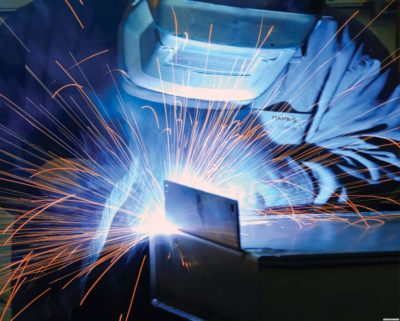
When making POV, you will have to use a weld
We make the frame
Lay the pipes in the desired shape. Fasten the joint corners by welding. Be sure to measure the diagonals. Their unevenness can provoke a skewed POV.
Weld the seams so as to protect the inside of the frame from the ingress of liquid. Then remove the internal dimensions and cut the corresponding frame from the 2 * 2 centimeters tube. Collect it in the same way as the outer one. Connect these two frames, align on one side.
Remove the debris from the frame, treat it with a soil mixture. After it dries, cover the structure with paint.
If you use a joint venture in the process, then it is more rational to use an Ω-shaped frame. The panel needs to be inserted into it. Doors made of profile decking must be reinforced with corners.
We fasten the canvas and locks
First, cut off the heels of the carriages. Then connect the resulting structure to the frame. Determine the spacing of the carriages according to the width after the fact
It is important to make sure that the canvas overlaps the opening on the sides by twenty centimeters, on top - by ten centimeters. The gap between the POV and the floor should be about five centimeters
When cutting the canvas, you need to be guided by the inner size. The finished canvas should lie on the frame located inside, with as little clearance as possible. Self-tapping screws and rivets are suitable for fastening.
If you will put a mortise lock on the gate, then you need to first think over the place of its attachment.
We make and install the frame at home
The frame is needed for POVs standing at the entrance to the territory. Pipes 12 * 12 centimeters are suitable for its manufacture. The beam must be larger than the structure. Its length must correspond to the size of the gate in the open position.
Then the pipes, which serve as vertical support, need to be buried at least 125 centimeters in the ground and concreted. This process must be constantly monitored by the building level. If even a slight misalignment occurs on the beam, the unlocked POV can open and close independently.
We install NE and accessories
Fasten the NE of the hinged gate so that its working area "looks" down.
If the NE is six meters long, you can simply weld on the missing piece. The alignment of the part can be done with special screws with brackets. In the process of work, the use of a building level is mandatory.
The rollers must be attached to the top of the structure on both sides. Now you can hang the gate. The rollers need to be put in the middle of the rail and the plugs sold in the kit must be installed.
The handle and locks can now be installed.
Top hanged doors are a modern version with high reliability. With proper use, they can last more than fifteen years.
Instead of POV, you can install a cantilever type structure. They are mounted in the same way, but their guide bar can be positioned at any height.
To prevent side swinging, secure the gate leaf with a stopper.
The knurled roller included in the kit can act as a stopper. Caps can be used to cover the ends of the rail.
If you want to place the gate more than three meters, you need to use the NE to fix the bottom of the gate.
Base arrangement technology
Making the foundation for sliding gates with your own hands requires a fair investment of time and effort. For a correct support device, it is necessary to perform accurate calculations and follow the technology recommended by professionals. The most common and rational is the frame-monolithic base, the following is the sequence of its creation.
Scheme development
To calculate the dimensions of the foundation, the following indicators are determined:
- soil type;
- opening width;
- weight and dimensions of the gate.

Foundation scheme for sliding gates
The optimum depth of the base is within 150-250 cm, it depends on the level of freezing of the soil, the sufficient width of the foundation is 50-70 cm. At the entrance zone, on one side, there should be an indent necessary for the rollback of the canvas. All dimensions and calculations are entered on the diagram, a drawing is drawn up, on the basis of which further construction activities are organized.
Preparatory stage
To create the base, you will need the following materials and tools:
- crushed stone, cement and sand are used for mixing concrete mortar;
- console blocks;
- wooden building materials (in the event that the work will be carried out with formwork);
- concrete mixer or trough with a shovel;
- scrap, tape measure;
- longitudinal steel channels;
- reinforcement, which will be laid in the crate;
- welding machine;
- building level;
- hacksaw, ax, hammer.

To create a foundation for a sliding gate, you need a welding machine
It is necessary to carefully level the area around the entrance group, remove vegetation and remove the roots. Next, they begin to dig a trench in accordance with the scheme, sand and gravel are sequentially laid and rammed on its bottom. This cushion will prevent the foundation from pushing out in the spring when the ground is unstable.
Assembling the metal frame
To make the foundation reliable and strong, it is reinforced with an embedded component - a U-shaped frame. The posts of the latter are made of reinforcement with a diameter of 12 mm, a horizontal channel 20 cm wide is used here - it will help to evenly distribute the load throughout the product. The length of the mortgage is determined by the dimensions of the opening - as standard, this is half of the same parameter of the entrance zone, that is, for a 4-meter gate, a 2-meter frame is required.
The U-shaped profile needs transverse reinforcement with a step of 30-40 cm; 2 methods are used to assemble it:
- welding of the reinforcing frame and further fixing of the channel;
- welding of rods and corners to a metal workpiece.
For bandaging the reinforcement, welding or steel wire is used. The top of the metal pins should not protrude from the soil surface. The building level will help check the horizontal installation of the workpiece - this way you can avoid skewing the structure.
Filling the foundation for sliding gates
For mixing the mortar, sand and cement are used in a ratio of 3: 1, the addition of crushed stone will increase the strength of the product. The trench is poured with concrete so that the reinforcement is about 2/3 covered with the mixture. In such conditions, it will be easier to install the gate. It is necessary to pre-mount the pillars supporting the entrance group, in this case the foundation will cover the cantilever supports, the entire opening. Thus, the entire plane under the sliding sashes will be completely concreted.
It is important not to skew the frame
It is important not to skew the frame. For the structure to function properly, the space under the roller segments must be wide and level.
A stable and reliable base is formed when using high-quality cement, the M500 variety is optimal, the permissible fractionation of crushed stone is 30-40. The foundation will get stronger in 2 weeks, but before use it needs to stand for 28 days.
To make a high-quality base for sliding gates, special attention should be paid to the calculation stage: given the large weight and mobility of the structure, you need to find the optimal ratio of operational and strength characteristics. With strict adherence to construction technology, you can expect the proper functioning of the automatic system in all seasons, the absence of distortions that lead to jamming, long-term maintenance-free use and an impressive working life.
DIY sliding gates: photo report with explanations
These gates are made on the basis of a ready-made set, the frame was made by ourselves, and we also assembled it ourselves.
The gates were set in Moscow, respectively, the prices are in the capital. They were installed in 2010, since then the kits have become much cheaper. For example, the "fresh" price of a drive for a blade weighing no more than 400 kg (there are up to 1.2 tons) is about $ 100, but this is a budget option. During the construction period, Rolling Center components were purchased (the best on the market at that time) with a leading beam 6 meters long. The upper catcher and bracket were also ordered separately. Everything with delivery cost about $ 600.
The following materials were also purchased:
- profile pipe 80 * 60 mm - 6 m, 60 * 40 mm - 18 m, 40 * 20 mm - 36 m;
- channel - 180 mm - 3 meters, 200 mm - 2.4 meters;
- reinforcement 12 mm - 6 m;
- electrodes - 2 kg;
- paint - 3 cans, brushes, rivets;
- cement M-400 - 5 bags;
- corrugated board was bought during the manufacture of the fence.
Scheme of sliding gates with dimensions
The first step was to weld a gate frame with a counterweight. The frame (in black) was made of a profile pipe 60 * 40 mm, lintels and an inner frame (lilac) from a pipe of 40 * 20 mm. At the bottom, a guide beam is welded with a cut down.
How the frame was brewed
The inner frame was welded with an indent from the edge - 20 mm on each side. So it is more convenient to fasten the profiled sheet later, if you wish, you can sheathe it from the inside.
How to weld a profile pipe 40 * 20 mm
First, the foundation was poured. Fittings were installed in it, on top of the channel with the back up. Close to the channel there are two posts made of a profiled pipe 80 * 60 mm. One stand is adjacent to the post, the second is set vertically at a distance of 120 cm. Rollers are then hung on them, which hold the canvas from above. On the other hand, a 180 mm channel was installed along the counter post.
Channel 180 mm attached to the counter post Fitting on site
Fitting on site
On the counterpart to the channel at the top and at the bottom, catchers are fixed, which will not allow the gate to dangle in the wind.
Stops mounted on the receiving post Top and bottom catchers
Top and bottom catchers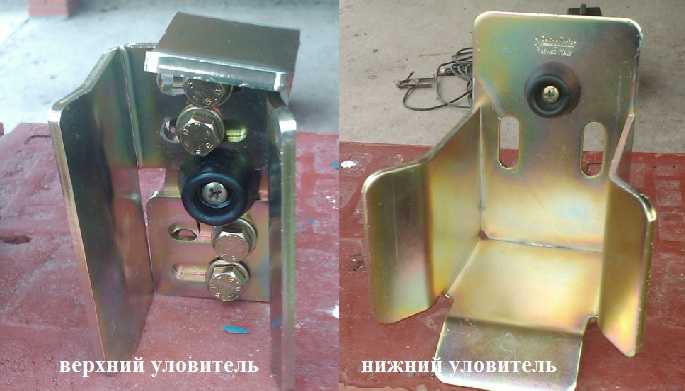
The next step is to install the roller plates. They are attached to mortgages. In this case, this is a channel, because the space turned out to be large. When the foundation was made, it was made too high, because the plates were welded directly to the mortgage. This is impractical: if the video breaks, it will be problematic to change it. Usually, a platform is welded, to which a platform with rollers is then bolted.
Roller platforms are welded and "run over" with rollers
The finished gate frame is simply rolled onto the fixed rollers.
Photo of a sash on rollers from different angles
After installation, plugs are put on the support beam at both ends. On the far side, a thrust wheel is also installed, which in the closed position drives into the lower catcher, raising the gate and removing the load from the rollers.
Installing the plug and thrust roller (the beam in the photo is inverted)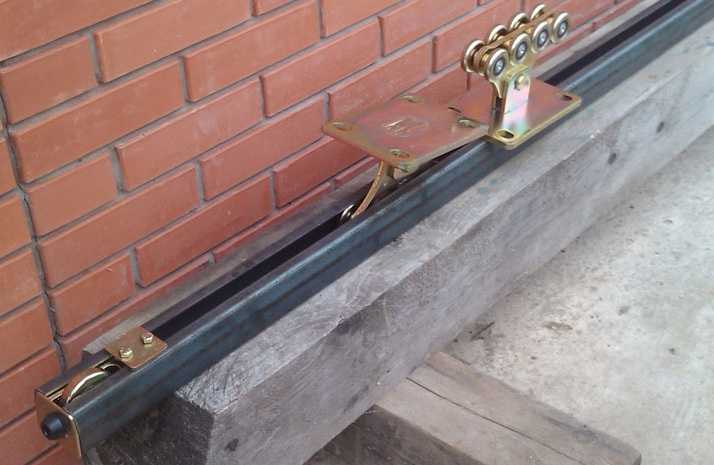
Now, so that the gate does not "walk" in the upper part (they are now not fixed by anything), sets of upper rollers are attached to the posts (80 * 60 mm) - one per post. They are practically put on the frame. Now the rollers inside will hold it at the top.
The upper rollers are attached to the posts, gripping the upper edge of the gate This is what the top rollers look like.
This is what the top rollers look like.
Everything, sliding gates with their own hands, are assembled and ready for use.
What a sliding gate looks like from the yard
If you have any questions, watch the video. A ready-made kit is assembled in it, the whole process will become clearer.
What are the gates
There are sliding gates of different designs. Console structures are considered one of the best. The fastening principle is that the canvas is attached to a beam installed on the foundation. Roller carriages act as fasteners. The peculiarities of this system are that the canvas is located at a height of 8-9 cm from the ground, does not come into contact with the ground and is able to move even in the presence of snow.
Console systems can be of any size. The absence of an upper beam allows vehicles of any height to pass through. Installation of the structure is relatively simple, pouring the foundation is inexpensive. The opening can be of any size; it is not necessary to design it in advance. Opening can be manual or automatic.

Conventionally, the disadvantages of the structure can be considered the complexity of the design, the need to align the side walls of the opening. The side of the fence, along which the canvas moves, must be free of foreign objects.
Suspended sliding gates are used mainly in enterprises. They are expensive and therefore not in great demand. The structure is a beam fixed above the opening. The web or canvases are suspended from the beam and move along it.
The advantages of the design are reliability, resistance to wind loads, no size restrictions and the ability to use a heavy canvas. This design is not susceptible to breaking. However, the overhead beam defines an upper limit for the height of the vehicle to be passed. The leaves are cumbersome, installation is possible only in a pre-prepared opening.
The simplest of the designs is the rail. Rails are mounted along the opening, along which the canvas moves. The canvas is kept in an upright position by means of a bracket fixed to the post. With the help of such systems, large openings can be closed, they have good wind resistance. The cladding can be made from any material.
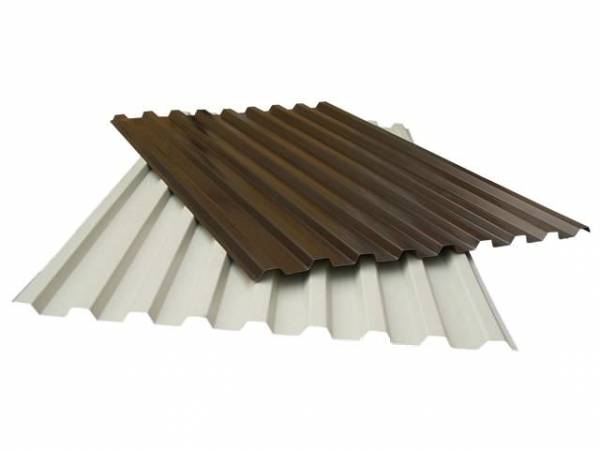
The disadvantages are the need to prepare the opening and the need for the structure to periodically clean the rails.
Design options are possible, instead of a concrete foundation, they are installed on several piles. Metal piles are screwed into the ground 1.5 meters, they become the basis of the entire structure. By choosing sliding gates on screw piles, excavation and concrete work can be avoided.
This option is worth choosing if you need to mount the entry group quickly. Sliding gates on screw piles can be installed even in a day, while their reliability is higher than that of similar structures on a strip foundation. Pile foundations can be made in winter.
Fireproof gates
The most important type of sliding gates is fireproof. Fireproof sliding gates are installed on objects where it may be necessary to isolate a burning room. The task of such products is to prevent the spread of fire to new territories.
The movement system is usually rail, and the thickness of the web is much greater than that of household options. A sectional or one-piece panel, consisting of 2 steel sheets with a non-combustible filler between them, ranges from 7 to 10 cm. The thickness determines the fire resistance, the weight of such a sheet is from 40 to 60 kilograms per square meter.

The design includes one or two sashes, it can also be telescopic. In the latter version, there are two or more valves, they all move to one side and are placed one after the other. The design features, requirements for the opening and the significant cost of the product dictate the need to calculate the structure used in each case separately.
DIY sliding gate installation
Foundation
This is probably the most responsible and important element of the entire structure. To begin with, the foundation is required for a mortgage, where the support rollers will be fixed. Some companies and private builders offer a more economical base option than reinforced concrete, namely, they propose to screw a pair of screw piles, where the mortgage is then welded upward, and now, by and large, almost everything is ready.
Then, next to it, another one is screwed into the bundle of piles slightly obliquely (since there are not many piles exactly next to it), under the pillar. We will not even consider this method. Probably, it will fit light and small sliding gates, for example, 2.5 meters long with a light frame, but the larger long gates will "walk" on this basis.
We believe that in this case there is no alternative to a reinforced concrete foundation, but it can also be performed in different ways. So, for example, it is often proposed to fill only one foundation - directly under the mortgage, or two separate ones, one of them - under the mortgage, the other - under the "receiving" post.
This option is much better than the very solution of installing screw piles, but the presence of two separate foundations can end in failure, especially in cases where these foundations are not below the level of freezing of the earth. It's just that as a result of frost heaving, these individual foundations can move independently of each other.In this case, even with small displacements relative to each other, everything can end with the gate not getting into the catchers that are on the receiving post, and you will need to readjust them all the time.
The solution to this problem is very simple (but more expensive than two separate foundations) - both pillars must be connected by one foundation. In this case, even if the base is displaced, both pillars will constantly be located parallel to each other, moving in one bundle.
Pillars
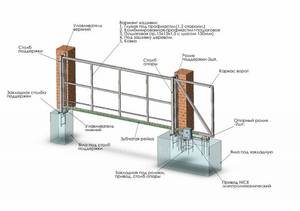
Regarding whether it makes sense to put U-shaped pillars or ordinary ones - there is no general opinion. The accessories can be installed without problems on single posts. But the U-shaped version is better, this option is preferable in the case when in the future you plan to supply not only the drive, but also a set of automation for the gate, which includes photocells. To begin with, it is much more convenient to install photocells on the inner poles, and not on the poles outside (taking into account anti-vandal considerations). And also, inside the pillars inside, it is quite convenient to lay hidden wiring to the signal lamp and photocells.
Frame construction

infill in the form of stiffeners
It is advisable to immediately weld the toothed rack (or threaded cylinders for fastening the toothed rack) to the frame. Gear rack fasteners (threaded cylinders, 3 pieces per meter of rack) are included in the kit as standard. Be sure to check this fact at the time of purchase! In order to then install the automation without any problems. Otherwise, then it will be very inconvenient to weld it evenly to the bottom of the canvas.
Its length must be at least one meter of the length of the opening. This one extra meter (or even more) of the rack goes to "counterweight" to constantly mesh with the cogwheel of the carcass drive motor. The toothed rack is universal and will fit 99% of drives (NICE, CAME, Alutech, Dorhan and so on). If you weld threaded cylinders for further fastening of the gear rack, then it is advisable to weld them first to the guide.
Also, do not forget that if you want to install a wicket in a sliding gate (by cutting the wicket directly into the door leaf), then it must be done in that part of the gate that is closest to the supporting rollers on which the leaf is held. If you want to make a wicket at the far end of the curtain from the gate rollers or the middle one, then you can significantly disrupt the balance of weight distribution, strength, "increase the lever", that is, those indicators that affect the rollers.
Yes, sliding gates can be quite expensive, but with their manufacturability and simplicity of design, they will give a big head start to lifting and swing gates. Installed clearly in compliance with technology, they are less likely to jam and deform.

